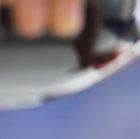
The Art Of The BOOKSHELF
WHAT DOES YOUR LIBRARY REVEAL ABOUT YOU?
Julie Andrews
A CONVERSATION WITH THE SILVER SCREEN LEGEND
Nuclear Arms
THE PATH TO ELIMINATING THE THREAT OF ATOMIC WAR




WHAT DOES YOUR LIBRARY REVEAL ABOUT YOU?
Julie Andrews
A CONVERSATION WITH THE SILVER SCREEN LEGEND
Nuclear Arms
THE PATH TO ELIMINATING THE THREAT OF ATOMIC WAR




The Joint Support Range is professionally designed to give soothing support and relief to those who suffer joint and muscular discomfort such as arthritis, tendonitis or sports injuries. The unique fabric contains ceramic particles and is designed to absorb body heat and reflect it back into the muscles and joints. The neoprene / polyamide material is designed to give balanced support and soothing heat distribution. Lightweight and discreet, the supports stay snugly in place whilst in use, so no-one knows you are wearing them. One size fits all.



We asked an independent research company to test our Knee Strap. The results were fantastic and now benefits of the Knee Strap speak for themselves - as ordinary, everyday, people confirm what we already knew! The Knee Strap Works! The Independent research company asked a panel of men and women, who suffer from knee pain to try our Knee Strap. When asked “Did you feel relief around the knee whilst using this product?” 70% gave a resounding YES!
The Knee Strap is so effective because it helps support the patella (kneecap). It is comfortable and lightweight and virtually undetectable under clothes.
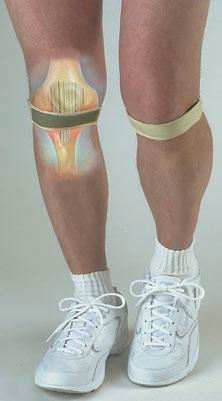
Cutaway view showing the patented strap












In fact 95% of our respondents agreed that Knee Strap is “lightweight”. 70% agreed that “Knee Strap gave relief from joint pain” and, finally, 68% said “The relief I get from using this product is so appreciated”. So there you have it - conclusive independent research proves that the Knee Strap provides immediate relief from knee pain! Now you can enjoy walking, climbing stairs and immediate, comforting relief from knee pain.
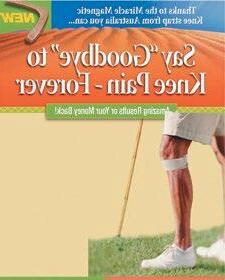
16 IT’S A MANN’S WORLD
Olly Mann harnesses his years of working from home to offer some timely advice
ENTERTAINMENT
20 INTERVIEW: DAME JULIE ANDREWS
We speak to one of the all-time legends of cinema about her illustrious silver screen career
28 “I REMEMBER”: BJÖRK
The outlandish Icelandic singer/songwriter takes us on a vivid trip down memory lane
HEALTH
38 HOPE FOR BACK PAIN
Here’s how some surprisingly simple lifestyle adjustments could end back ache for good
INSPIRE
56 THE BENEFITS OF WALKING
An ode to the plethora of health benefits walking offers


64 MY BRITAIN: LIVERPOOL
How a long-neglected city shed its once dingy reputation
74 THE CASE FOR NUCLEAR DISARMAMENT
Nuclear weapons have been a global reality for years. Here’s why that needs to change
82 READING BOOKSHELVES
What does a bookshelf have to say about its owner?
£165 for Reader’s Digest readers (RRP £295.99)


THIS SOLID, BEAUTIFULLY MADE, QUALITY PIECE MAKES IT EASY TO RELAX!
• Fully reclining hardwood sun lounger with side pull out table (slides to left or right) and luxury cushion with head pillow included
• Stained, oiled and gently rubbed down by hand, the finish is a delight and matches Plant Theatres outdoor garden furniture ranges
• Plant Theatre’s sun lounger comes with extended wooden handles and wheels for easy manoeuvrability
• Delivered flat-packed and part assembled, easy home assembly with full instructions included.
• Dimensions: Sun lounger L 198cm x W65 x depth from ground 34cm (excluding cushion

Fully reclining sun lounger made from Acacia hardwood from sustainable sources has been stained, oiled and gently rubbed down by hand, the finish is a delight.
It has a pull-out side table which slides from left or right or can be completely hidden, plus extended wooden handles and wheels for easy manoeuvrability.
A specifically made luxury cushion with double piping, fabric ties and removable head pillow is included, all covers have zips and can be removed for washing.
The sun lounger arrives flat-packed and part assembled for easy home completion with full instructions included.
delivery normally within 3-5 working days.
plant-theatre.co.uk/reclining-hardwood-sun-lounger-with-luxury-cushion.html

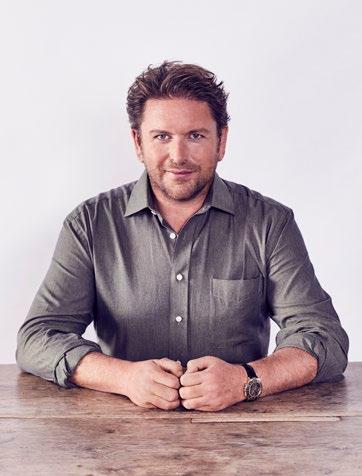
READER OFFER
15% OFF HEALTH SUPPLEMENTS FOR ALL OUR READERS
If you need an easy and convenient way to get more greens in your diet, why not try Prime Fifty’s new e ervescent super greens tablet which is the first of it’s kind available in the UK. It’s received great reviews for its well-researched ingredients list, ease of use and superior taste – with a melon and lime flavour which makes it an altogether tasty and refreshing drink that you can take daily. £23.00 for a 1-month supply.


TAILORED TO THE 50+

RECEIVE 15% OFF YOUR FIRST ORDER
USING CODE DIGEST15









Designed to nourish and protect your skin, hair & nails from within - these “Beauty from Inner Health” supplements have been exclusively formulated by Prime Fifty to meet the unique needs of the over 50s. Created to supplement your diet using an age-specific multi-nutrient formulation, comprising the most essential vitamins, minerals and natural extracts to help you feel good in the skin you’re in. £65.00 for a 3-month supply.





SENIOR EDITORS Anna Walker, Eva Mackevic
EDITORIAL ASSISTANT Jessica Summers
ART DIRECTOR Richard Cooke
ADVERTISING Jigs Pankhania
MARKETING Sarah Hughes
HEAD OF FINANCE Santwana Singh
FINANCE MANAGER Irving Efren
MANAGING DIRECTOR Julie Leach
CHAIRMAN Gary Hopkins
TRUSTED MEDIA BRANDS INC (USA)
President and Chief Executive Officer
Bonnie Kintzer
Vice President, Chief Operating Officer
International
Brian Kennedy
Editor-in-Chief, International Magazines
Raimo Moysa
WE PAY...
£50 for the star letter and £30 for regular letters.
Email readersletters@readers digest.co.uk or go to readers digest.co.uk/contact-us
WE ALSO PAY...
£30 for the true stories, anecdotes, jokes in Laugh! and You Couldn’t Make It Up…, and contributions to end-ofarticle fillers and My Great Escape
Email excerpts@readersdigest.co.uk or go to readersdigest.co.uk/contact-us
We cannot acknowledge or return unpublished items or unsolicited article-length manuscripts. Do not send SAEs. Article-length stories, poetry and cartoons are not requested.

Contact Customer Services for renewals, gifts, address changes, payments, account information and all other enquiries. Call 0330 333 2220* or email customer_service@readersdigest.co.uk
Reader’s Digest is also available in audio and accessible etext editions from RNIB Newsagent, for blind and partially sighted readers. Call the RNIB Helpline on 0303 123 9999 or visit rnib.org.uk/newsagent
Annual subscriptions are available to be delivered monthly direct to your door. For our latest offers please visit readersdigest.co.uk/subscribe
Or telephone us today on 01778 392461
Gift subscriptions also available. UK rates may vary. Overseas rates: Republic of Ireland €50, Rest of the World €60.
Turning ideas into investments.
Interested in learning more about investments? Have you built up a cash sum or a fund for your retirement. Do you want to improve on the returns from your bank or building society? If this is you then why not take advantage of our free offer and start to learn a little more about investing with our FREE Guide. To order your FREE Guide just call us now on the number below quoting Readers Digest or visit our website www.fathomfinancial.co.uk/readers-digest
Call 0800 043 8341 today to request your guide or visit fathomfinancial.co.uk/readers-digest
Please note: The value of investments and any income from them can fall as well as rise and you may not get back the full amount of your investment. The information provided here is for guidance only and is not advice. If you are unsure about the suitability of an investment please seek advice. Tax rules can change. We record all calls for training and monitoring purposes. Lines are open Monday to Friday 9am to 5pm. Fathom Financial Limited is an Independent Financial Adviser based in the North East of England. Fathom Financial Limited is registered as a limited company in

Take a look at your bookshelf. What story does it tell? Is it filled with well-thumbed favourites? Hardbacks with glossy covers, still awaiting their time in your hands? Recommendations from friends, slowly working their way to your bedside table? On p84, Lottie Fyfe explores the tradition of the bookshelf, and the often emotional space our bookshelves take up in our lives. As writer Alan Bennett said: “A bookshelf is as particular to its owner as are his or her clothes; a personality is stamped on a library, just as a shoe is shaped by the foot.”
You’ll notice that we’ve been working on some changes to your magazine this month, and we’d love to know what you think. Email readersletters@readersdigest.co.uk and share your thoughts!
As a rock obsessed kid, my pantheon of role models was exclusively male. I associated femininity with meekness, and got my kicks out of watching Kurt Cobain shredding his vocal cords or Keith Moon smashing up his drum kit. Until one day, I saw Björk’s “Bachelorette”. Discovering her changed everything for me. Her fierce, wild energy and forbidding vocals were coupled with a powerful sense of sensuality, even a certain infantilism. She embodied everything I admired about these male musicians but imbued it with femininity that spoke to me, a 13-yearold girl, like nothing had before. Now, over a decade later, I’m incredibly excited to feature her in this month’s “I Remember” column, where she talks about school, her band, the Sugarcubes, and her native Iceland.
facebook.com/readersdigestuk

twitter.com/readersdigestuk @readersdigest_uk
You can also sign up to our newsletter at readersdigest.co.uk
Reader’sDigestis published in 27 editions in 11 languages
We pay £50 for Letter of the Month and £30 for all others
With reference to Max Pemberton’s article, “Numbers Over Nurses”, it’s worrying that targets and statistics now come before the dedicated, hardworking staff who—one by one—are leaving the NHS due to extreme pressure, lack of being heard and the disillusionment of higher management. Surely care is priority, the best care, by the best staff possible. Targets are sometimes impossible and we should have concern for the nursing staff and others that we are losing because of the unachievable tasks put in front of them. NHS staff will step up to the mark as the coronavirus takes hold, as they always do in times of need. Let’s give them the credit they deserve; forget targets and concentrate on letting them get on with their jobs and doing the best they can with the resources available. Their bravery, empathy and passion to help others should be applauded and the NHS should be doing their utmost to hold on to them.
GERALDINE SYSON, Glasgow

I enjoyed Graham Coxon’s “If I Ruled The World” and agreed with him on so many counts, especially about the government giving financial support to creative artists such as painters and musicians. Support is vital to these people if you consider the proportion of them who are living in poverty. Only a few who have achieved success in their field, are able to support themselves, whereas some other are living below the poverty line.
Perhaps the construction of a non-profitable art gallery, which helps the public to develop a sense of art, would help—and with financial funding by the fovernment, our cities would be more interesting and attractive.
KAZZA SEVILLE, Merseyside
Send
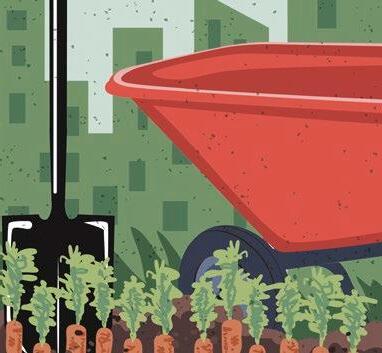
I particularly enjoyed reading “‘The Good Life.” Following a bout of anxiety and depression
I found myself seeking positive ways to help improve my health. I only have a small garden but I have made some big changes within it to try and incorporate the growing of vegetables and fruit. I loved your advice on how to grow certain crops in modest gardens and even balconies and this has certainly given me more enthusiasm to grow even more. There is something magical about watching the first green shoots appear through the soil. I feel I have created something positive and worthwhile and this sense of productiveness really helps with a low mood. Being outdoors is also a boost to a tired mind and it cannot be a coincidence that I feel revitalised and much happier after I have spent time outdoors nurturing my plants. The joy of being outside tending to my humble collection of plants is all I need right now to help me feel better.
SUSANNA LEWIS, YorkshireI could relate to your article “Older And Wiser.” I think it’s wonderful that so many adults are experiencing university life and gaining degrees, regardless of age. For years I regretted my decision not to go to university. Then, when I had a serious injury to my back and could no longer work, I started to think about what I could do with my life. I decided to go to university. Unfortunately, I wasn’t physically able to go to university but that’s when I found out about Open University. I could study from home and still get a degree. It took me six years, but I loved it and when I stood on the stage at my graduation, I felt on top of the world.
ESTHER CHILTON, Berkshire


“May you live in interesting times”
For many years I believed that this was a Chinese proverb or if you like a curse, however I have been enlightened of my ignorance by “the mighty” Google who informs me that the quote originally appeared in “The Yorkshire Post” in 1936 from a speech made by Sir Austen Chamberlain, so there you are it must be true! He also reportedly said “We move from one crisis to another. We suffer one disturbance and shock after another”. He could well have coined that phrase today. We’ve had “Brexit” (ahhh sorry!), Trade Wars, disrupting global (err) trade and the dreaded Coronavirus. At the time of writing this article the United Kingdom and America are yet to reach peak infection rates and sadly deaths. Here’s hoping that by the time of publication the dreaded
disease is in retreat and we are returning to our “normal lives” whatever normal is for you!
Over the last months and years we have spent a great deal of time talking to people about how to invest and when to invest. The how (actually) is easier than you think, as to the when, that can sometimes be a little tricky! So let’s start there then;
When markets are rising should you invest? When they have fallen should you invest? The answer isn’t as clear cut as it may seem, “why?” I hear you ask. Because it isn’t that simple, life and especially investing never is. You may be buying into an overpriced market (when it’s going up... and down!). Equally you never know when the bottom is going to come, the old adage “trying to catch a falling knife” springs to


mind. Not very helpful so far? My advice to clients over the last 30+ years (yes I said it!) has been linked to an analogy that (so far) I’ve only heard me use. So here goes;
If you go to the seaside and the wind is blowing a gale, the waves are pounding the beach, skies are grey, it’s cold and raining you wouldn’t go in for a swim (well I wouldn’t!). If on the other hand the sun is cracking the pavement, the sea is calm and inviting you’d, I expect, be straight in. All I’m trying to illustrate here is that when things look very uncertain you wouldn’t “dip your toe in the water”. Let me be clear, we never try to time the markets as we firmly believe that it is “time in the market” that counts however you wouldn’t volunteer for scenario one at the beach so why would you jump in with your hard earned cash.
The how of investing is generally, for most people much easier. You should establish your investment goals; do you want income, growth or a combination of both. Think about your time horizon and the returns you need to achieve these goals. You must consider how much risk you are willing and able to take to achieve your objectives (you can use on-line risk profiling tools to help here).
Then invest in a balanced and well diversified investment portfolio that aligns to your risk profile. Once you are invested, if you find yourself in a “squall” and over the medium to longer term you certainly will find testing times (another Seaside analogy - I don’t even go to the beach - well not much anyway) you must stick to your strategy. Don’t be tempted to sell when markets fall unless you really, really need to (you should consider your short and medium term cash requirements before you invest). If you sell into a falling market you will crystallise your losses and find it very difficult to recover from them.
On a positive note, if you want to achieve better returns than your bank or building society, over the longer term a well balanced and diversified investment portfolio should do it every time. If you would like a FREE copy of our Beginners Guide to Investing please call 0800 043 8341 or send an email to letstalk@ fathomfinancial.co.uk n
Mark Abley Managing Director at Fathom Financial.Tel: 0800 043 8341
Email: letstalk@fathomfinancial.co.uk
 Photo: © RGB Ventu R es/ s u P e Rs tock/Al A my s tock
Photo
Photo: © RGB Ventu R es/ s u P e Rs tock/Al A my s tock
Photo

the page

To visit this museum you will need to hold your breath! The Museo Subacuático de Arte in Mexico is not to be found in any city but rather on the floor of the Caribbean Sea near the island of Mujeres! Divers can enjoy more than 500 underwater sculptures, all made from a special concrete that facilitates the growth of coral and underwater plants. Because of this, the impressive art museum has since become one of the world’s largest artificial reefs.
Photo: © Getty Im AG es/Don A l D mIRA lle
Olly Mann muses on the small wins that make working from home more bearable...
Working from home? Me too. But, as it’s been over a decade since I turned my hobby (podcasting) into a full-time job, the nation’s coronavirus lockdown has not had an immense impact on my professional life. True, I can no longer go off to interview people face-to-face, script my links in a coffee shop, or attend a matinee and claim it back as "research" on my tax return. But for the most part, my working pattern hasn’t been much affected. Listeners don’t care whose house I’m in when I press record. This, I realise, may well not be

Olly Mann presents Four Thought for BBC Radio 4, and the award-winning podcasts The Modern Mann and Answer Me This!
the case for you. If you’ve only been stationed in your sitting room since the spring, and are still adjusting to life without an almond latte, crowded commute and a photocopier, allow me to share some home-working lessons I’ve learned over the years…
Get great slippers
When one is sprung with a videocall, it’s always best to present a formal top-half (like Will Ferrell in Anchorman, you could actually dispense with trousers altogether, although that’s not for the novice). But why bother with brogues, or high heels? You’re at home! And who wants to traipse about in socks all day, like a newborn baby?!
Treat yourself to some comfortable slippers. I have a pair of Ted Baker moccasins, because they’re more discreet than my Rudolph The Reindeer boots when I have to answer the door. You’ll save money on washing powder, too.

The web is a fabulous resource, but it’s designed to bedazzle you with news alerts, social media "likes" and Wikipedia worm-holes and, when you’re working from home, there’s no one peering at your screen, shaming you away from clicking on them. So, when you need to compose something that requires your full attention—a memo, an invoice, an important email—draft it first in a word processor, or even with pen and paper, rather than in a live internet window or on your smartphone. It’s amazing how much your brain can do when it’s not being nudged to do something else.
Choose your soundtrack carefully

the kitchenette offer an opportunity to stretch your legs, chat to colleagues and catch up on gossip. The resulting beverage is incidental, and, in most cases, appalling. But at home, you can (and should) indulge in good-quality coffee.
Since the lockdown, I’ve been getting grounds delivered from my favourite London coffeeshop, for a little taste of freedom. But it’s stronger. Noticeably stronger. So, don’t do as I did and glug back a whole pot of it in an afternoon, as then you will start shaking, and won’t be able to work because your heart will be beating too fast, and you’ll be too busy being rude to people to get any work done.
Radio offers companionship, and music helps concentration. But resist the temptation to put on something you really enjoy. If you’re in stitches over a DJ’s anecdote, or singing along to lyrics, you can’t truly focus on the job at hand. Hence, I consume a lot of Scala Radio (light classical music and film soundtracks, linked together with bland pleasantries). It doesn’t interfere with my neural pathways, and I’m learning a lot about Hans Zimmer.
Observe the effects of caffeine
In a traditional office, regular trips to
When the sun is shining, go outside
If you’re lucky enough to have a garden, use it. What a delight it is to break up a boring business call by upping sticks to the picnic table halfway through, unbeknownst to the other participant! Oh, the joys of an alfresco afternoon sorting through VAT receipts, conducted from my deck chair—maybe with a glass of rosé on the go, why not?
As it’s common for an hour of bright blue skies to precede a thundery downpour, schedule be damned, when you see the sun
shining—get out there! (Obviously this rule should be relaxed if you happen to be reading this during Britain’s one week of annual "heatwave." In which case, don’t spend all your time in the garden, lest you morph into Bryan Brown in Cocktail.)
…But the rest of the time, stay in your "office" There’s a louche appeal to the laptop, and a convenience factor to the kitchen table, but I’ve found I’m more productive working from a desktop in a designated home office. If you can’t spare an actual room, portion off a bit of your bedroom, or the shed, or some other annexe; but make it a permanent conversion, a place used for nothing else. Kids and partners are banned. Pets are actively encouraged, preferably sleeping around your feet for added warmth (apart from
goldfish —they’re best kept on the shelf). And do your online shopping somewhere else, or else you’ll constantly have a tab open so you can monitor when talcum powder is back at Boots.
And that’s it! With these six tips, my friend, you’re ready to supercharge your home-working experience. You’ll never miss going to the office again. But, as soon as you can, please do go back to the office. You’re cramping my style. n
The lifespan of a blue whale can be estimated by their ear wax, which builds up in seasonal cycles, somewhat like the rings of a tree
While the blue whale is the largest animal to ever live on Earth, the smallest whale—the dwarf sperm whale—is little bigger than the average person
Female Atlantic right whales lower their voices to a "whisper" when communicating with their young to avoid predators overhearing
Sperm whale sounds are so loud, they can burst a human ear drum. At 188 decibels, they're louder than a space shuttle launch (160 decibels)

Dame Julie Andrews reflects on her most iconic roles, the changing face of the entertainment industry and what really makes a great cup of tea
Longevity in the movie world is a commodity few can lay claim to, not least when the projects that made a certain star famous were being projected onto cinema screens over five decades ago. By that notion then, it seems unfathomable that Julie Andrews, an octogenarian—albeit only in age, given the elegance, sharpness and energy she invests in press and social engagements—hadn’t even hit 30 when Mary Poppins and The Sound of Music enchanted a nation.
Those two movies, released within seven months of each other as a cheerful, charming countenance
to the vigour and fervour of the emerging Swinging Sixties, weren’t the first taste of success Julie had experienced. Raised in Waltonon-Thames in Surrey, her parents separated when she was young, and while the relationship with her father was strong, it was her mother’s desire to perform that ultimately influenced the performer.
Having endured a level of poverty and hardship with mother Barbara and new partner Ted Andrews, the UK’s emergence out of wartime saw a huge demand for the entertainment doyennes who had so greatly livened the spirits of troops. And by 1954,

having already performed on the West End stage and at the London Palladium, she found herself leaving UK shores for a stint on Broadway.
“The speed with which opportunities came along was really very reflective of how the country was getting back on its feet after the war,” she begins. “I’ve always considered myself very fortunate to have been the age I was, at a time when people were thrilled to be free again, desperate to be entertained and intent on moving forward without fear of what war brought about.”
After a number of years on stage, her screen debut came in 1964 with Mary Poppins—a movie that truly catapulted the actress into full, fervent acclaim. She was hand-picked for the role by Walt Disney himself, who had seen her star as Queen Guinevere in Camelot on Broadway. Speaking at the premiere, the film producer, animator and entrepreneur said, “She turned me down! I couldn’t understand it.
With the happy arrival of her daughter, Emma—now a successful book author, theatrical director and actress—Julie was soon to be bombarded with the adulation expected of someone at the peak of her powers, and across a film industry finally revving up again after years of neglect.
“WE WERE HAPPY TO WAIT FOR HER, BECAUSE WE KNEW HOW PERFECT SHE WAS FOR THE ROLE”
“It soon materialised it was because she was pregnant with her first child, and wanted to return to London. We were happy to wait for her because we knew just how perfect she was for the role.”
Double Oscar and Golden Globe acclaim, both for Best Actress in Mary Poppins, was complemented by another Golden Globe for The Sound of Music, and the success of those movies had seemingly set the actress up for a long trail of success. In reality, her love of television projects, particularly in a long association with broadcaster ABC, plus inconsistent film choices— both Star! and Darling Lili are regarded as two of Hollywood’s biggest flops of the era—curtailed what might have been a more extensive portfolio. By the time the 1980s had come around, modern filmmaking brought about younger central characters, equipped with more impactful and increasingly brash personas; so too then did Andrews recline into the shadows.
Many have speculated that the actress was given something of a poisoned chalice very early in her

career. It quickly became apparent that she may never land roles of the magnitude of her first two film projects—their ability to enchant and empower an audience to truly throw off the shackles, celebrate life and sing from the rooftops, was unique.
“I’ve never seen that as a bad thing,” she says. “To have a major role, or a handful of major roles, is something that doesn’t have to determine the future.
“In modern entertainment today we ultimately have things which are throwaway, and I say that in a positive way—some people like to come home after a long day at work and watch television that doesn’t make them think; or they like to wind down with a book. And that’s
fine. You can’t always be going after the big things in life.
“I don’t believe it’s healthy to look back and wish things differently— I am happy for every experience and if success came to me early then perhaps that’s just luck that I haven’t had to toil for so many years to get it.
“What I will say is I’ve never tired of people talking about The Sound of Music or Mary Poppins—to see people still thrilled by the originals, and enchanted once again by other versions, such as Emily Blunt’s brilliant reworking, is wonderful.”
Indeed, as far as Blunt’s Mary Poppins Returns goes, set 25 years after the original, the true enchantment seemed to come from the actress herself, who sought out
Julie for permission to reprise what is an iconic role.
Said Blunt: “When I heard that Julie Andrews had offered her approval for me to take on the role, I was close to crying. That was such a wonderful thing to be told and it gave me so much belief and confidence to take it forward.”
Julie responds: “I could never say no to that. Why… because film and theatre should be there so that we can all celebrate it—it should influence and enrich all our lives and it’s an honour to find that the work I’ve done has that effect on people still.”
The Dame’s revival at the turn of the millennium, as a generation of disenchanted filmgoers began to recognise again the actress’s iconic status, was aided by a supporting role in The Princess Diaries, the movie that launched the career of Oscar-winner Anne Hathaway.
modern cinema is now just as strong as her “golden era” of the 1960s—a true influencer whose greatness is now beyond reproach.
She’s also unafraid to drive forward with new opportunities. In 2017, Julie’s Greenroom screened on Netflix—a show that saw her link up with the Henson stable for a preschool performing arts show. It served to open up the Dame to a new form of entertainment delivery.
“I NEVER LOSE GRATITUDE FOR THE FACT THAT PEOPLE HAVE PAID MONEY TO COME TO SEE YOU”
“It was very enjoyable,” she says. “I believe we will see streaming services enjoying a really strong hold on things in years to come… as a direct competitor to television, but also as an alternative to the conventional film market.
“Everything these days is about convenience and offering a project to a vast but real, passionate audience who can watch and enjoy on their terms, and on a variety of different devices—that’s what we need to deliver.
Acclaimed work, notably in the Shrek movies, pushed her relevance further—her talent for voiceover particularly pertinent given surgery she had on her throat.
Through Despicable Me, Aquaman and the upcoming Minions: The Rise of Gru, Julie Andrews’ imprint on
“The other big advantage was producing a stream of content in the knowledge there weren’t going to be any commercial interruptions. That’s a real advantage when you are looking to maintain a young audience’s hold on a story.”
Julie, who has lived full-time in
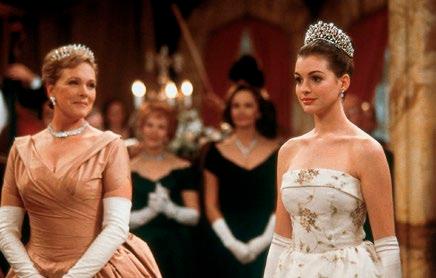

the US for many years, admits the things she misses most about the UK is a cup of tea. “I have been able to get a fair amount imported over,” she laughs. “I love PG Tips and there’s nothing like English tea.
“What I have found is the water does also make a difference—I don’t know exactly what it is about the water in England, so you’re never going to replicate it 100 per cent, but I think I am close and it is to my own liking!”
With another Minions instalment coming up, Dame Julie may well be leaning on the trusty tea leaf in order to lubricate her vocal chords.
“The funny thing is that I’ve never known why they chose me to play the role of an awful person in the film,” she laughs, referencing her character, Marlena Gru. “Maybe it was a tinge of irony to go against the
totally polar-opposite characters in the previous roles in my career; but whatever made them choose me, I am so very happy that they did.
“And the movies are always great fun to do, even if the voiceover work takes a bit of getting used to. It is completely different to a normal film because you’re just there on your own recording your parts. There are no other actors around you so it does take a bit of getting used to, but everything moves on and evolves in film-making and I’m glad I’ve been able to live through these different eras.
“The other thing about animated movies is, unlike on a live film, you really don’t have any idea what it’s going to look like until they’re finished. But I’ve watched them back and they are delightful to watch— a nice, modern take on life for kids. They are great fun.”


Even at 84, we might suppose Dame Julie Andrews still has many years of decorated acclaim in front of her. At a time when, globally, for once, we have the opportunity to reflect on those who have won our hearts, it seems all the more important and pertinent to offer respect, recognition and no small amount of gratitude to a performer whose presence lives on.
“I wouldn’t describe myself as a sentimentalist,” she offers, “but I think we all like to look back and celebrate important events and people.” And despite the advancement of age, Julie has rarely turned away the opportunity to speak about her life and her loves in front of an audience. “For me, it comes back to that whole idea of sharing,” she says. “When I’ve done events I always like to punctuate
the evenings with lots of footage, some behind-the-scenes stories and a background of what life and the entertainment industry has been like at certain points in my career.
“I never lose gratitude for the fact people have paid money to come to see you—whether you are on a cinema screen, on Broadway, or just sat in front of an audience talking about memories, you’ve always got to entertain.” She continues:
“I am always returned to that great Katherine Anne Porter quote about the arts where she says that no matter what happens in life you, cannot live without it: ‘The arts live on and regardless of whether there’s joy, pain, sorrow or death—there are always the arts to fall back on. They will out-live governments, societies and even the very civilisations which created them.’” n



“Björk” Guðmundsdóttir, 54, thrives on the mystery, mystique and mass contradictions of her craft. She is one of the music industry’s most respected artists; someone who you feel emerges out of every project with another layer of integrity. Here, she takes us on a vivid trip down memory lane…
…I COULDN’T CONCENTRATE FOR LONG ENOUGH TO BE ANY GOOD AT SCHOOL. I was drifting out of the window or finding ways to play percussion on the side of the school desk. It just wasn’t for me, despite the attempts of my headmaster to make it a place where I could harness some of the talent he saw in me. I just wasn’t interested.
MY TIME AT MUSIC SCHOOL WAS BOTH INSPIRING AND FRUSTRATING. My time there [Björk attended the Barnamúsikskóli School in Reykjavík] was very much focused on musical structure, history, theory and musicology, and I think when you’re studying that as a student it is very methodical, mechanical and serious, when all
you really want to do is experiment and create.
There were a combination of things I both loved and disagreed with, and I think I’ve had the opportunity to correct or fix those at various points in my career. For instance, I began using a touchscreen on my Volta tour in the autumn of 2008 to perform some of


my songs. The next extension of that was then to feel excited about writing with a touchscreen, rolling things around, and where you could be more tactile, intuitive and spontaneous, rather than hovering a finger over a mouse… and this was all two years before the iPad came out. So the opportunity for me to map out, on a screen, my writing process, sent me back to my music school years and it

was nice to feel some processes coming full-circle. A touchscreen for me solved the riddle because I was not totally satisfied with my music school when I was a kid. As an adult I feel like I am making up the class I would have wanted to have gone to when I was eight. And there have been various other episodes in my life where lessons I’ve learned have come back round to have really positive effects and influences on my adult song writing.
MY CHILDHOOD WAS PLAYED OUT IN A COMBINATION OF HOMES, living with various people— my mother, my grandparents, and in communes and little houses that would be filled with the most creative people. It seemed that everyone around me had a musical instrument so I really grew up with
music as the most natural thing— people would converse through music in a way that was much more sensitive and special, so I always viewed music as a way of communicating that had much more sensitivity and purpose than clumsy ways of talking to each other.
THE FIRST INSTRUMENT I LEARNED TO PLAY WAS THE FLUTE, but the first genre that really grabbed me was punk, which was still holding on in Iceland in the early 1980s. I was in a band called Kukl and that was the first time I really realised I could make a career out of music. Before that, the first song that really broke through for me was “I Love to Love”, by Tina Charles. It was sent to [radio station] RUV when I was about 11, and someone picked up on that. Would I have preferred it
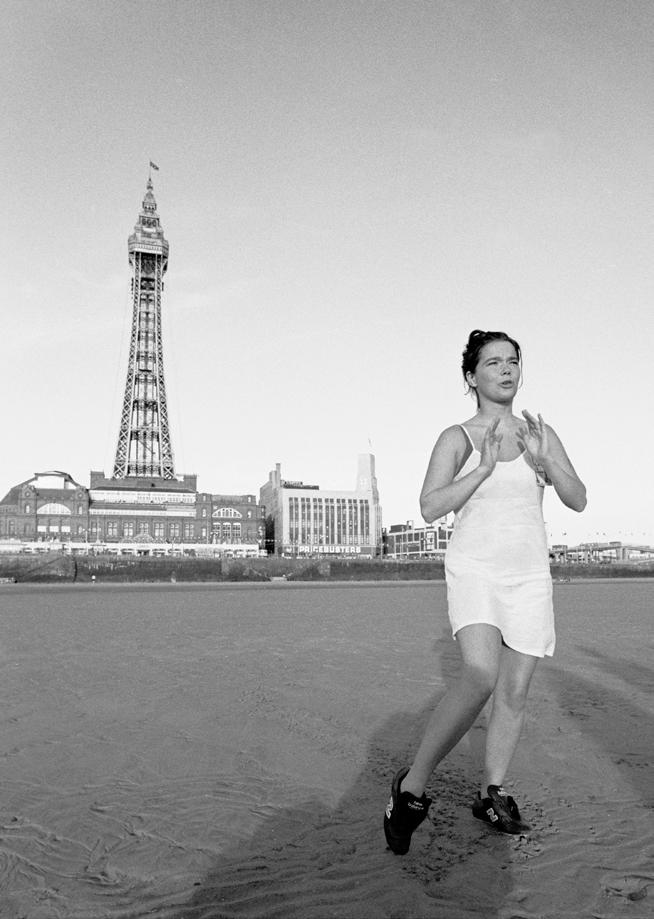

to have been a record different to that? Perhaps.
I MADE MY FIRST ALBUM AT TEN. I had always been subject to so many different styles and genres and ideas that by the time I came to make that first album I had so much music and so many ideas and I found it very difficult to stop.
FROM A YOUNG AGE I KNEW I HAD TO BE TRUE TO MYSELF in terms of what I was writing and how I was presenting myself as that person. I always think of Joni Mitchell in that regard. She has been very true to the person she is at that time in the sense of the lyrics she writes, and I would always be the same. My band, The Sugarcubes [above] wrote about adolescence, young themes,
independence and growing up. As a solo artist, I approach songwriting with a different maturity having been able to look back on life and think about what I have done.
I WOULDN’T BE THE ARTIST
I AM TODAY WITHOUT THE SUGARCUBES. I know some people see them as a stepping stone for my career, but we were a very close band and my time with them really gave me the confidence and methods for so much experimentation, even into electronic sounds.
TECHNOLOGY HAS BEEN A BIG PART OF MY PROGRESSION AS AN ARTIST. We are always told that musicology—scales, rhythm, arpeggio, chords—is just as difficult for us to learn as, say, reading Chinese, but now with the use of

apps and technology it’s as simple as learning how to read and write.
I HAVE ALWAYS BEEN VERY SELFCRITICAL BUT GOING SOLO INCREASED THAT. I’m on a mission and I’m my harshest judge. I could get the most terrible reviews but they would be nothing compared to my own criticism. I am a much harder judge on myself. I am still my master and my own servant… and it is
slavery sometimes… hardcore slavery. Lots of defeats, but also lots of gorgeous victories.
I WAS ALWAYS TAUGHT TO BE PROUD OF BEING ICELANDIC. You could put me on Mars and still I would always be Icelandic. In Iceland we hate the Danish and the Swedish and the Norwegians—it’s like the French and the English are always making jokes about each
other. Icelandic people are like the Finns—we think of ourselves as being like Finnish people, maybe because we were a colony.
To call something Scandinavian in Iceland is almost like, eugh. Icelandic people are anarchists, rebels, with crazy, chaotic energy. To sit down and be organised like a Scandinavian, with a pencil and paper and a ruler… it’s hilarious, and I always grew up knowing this to be the case.
I HAVE ALWAYS BEEN INSPIRED BY HAVING AN ACTIVE FAMILY who have grown stronger and stronger in everything they have done, and that has always been a big inspiration to me. They are typically late beginners and they go all the way in what they do.
RECORDING DEBUT WAS THE BIGGEST FACTOR IN TAKING ME OUT OF MYSELF because up until then I always thought that I would
live, exist and flourish in Iceland…
I thought all other countries were crap! Then it came to the point, when I did Debut, that I realised I needed to go on a mission and find people, new people, to teach me. In my job there’s no school—the only school is experience. I have been very lucky, I have worked with the most gorgeous people, and these people have taught me many, many things.
UTOPIA , I NEVER KNOW WHAT THE ENDGAME LOOKS LIKE. The only thing that is constant is that emotion comes in the way you sing, not just in lyrics. You can always work out a message based on the way something is sung rather than just what it is that is being sung, and my music has always been a combination of drama, acting, poetry and sound. If one of those is missing I won’t pursue it. n
As told to Simone Lee
Dentistry has been a painful business throughout history. In the 19th century, teeth often went rotten during early adulthood and patients were sent to a surgeon or barber, who would yank it out with pliers, without anaesthetic. Parents, wanting to spare their offspring frequent painful visits, would often pay to have all their teeth removed at once, to be replaced by a set of dentures before their wedding day.
SOURCE: HISTORYCOLLECTION.CO
There were ups
You’ve made a mark
There were downs
You’ve lived
Perhaps more than you realise
Triumphs Failures
And children
And now grandchildren
It’s time to tell your story
Love, laughter, tears
The gift of a lifetime
LifeBook is the world’s leading autobiography service. Around the world more than 8000 people already enjoy owning the life story of someone they love. Each book is a unique piece of family treasure, custom-made and handcrafted, to be shared by generations to come. It’s time to tell your story.
Find out how by contacting us on 0800 999 2280 or visit lifebookuk.com

Old advice: pain pills, hightech tests, shots, and surgery. The latest science: harness your brain, lace up your trainers, and go low-tech
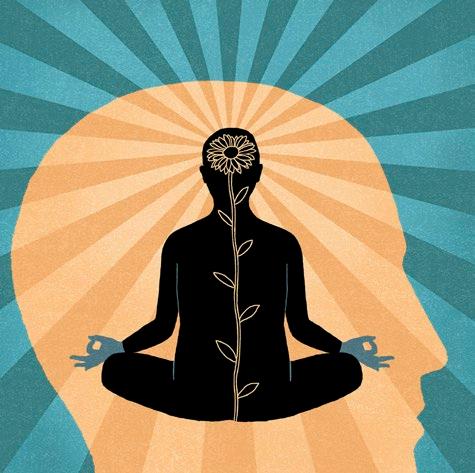
After Marty Huggins fractured her lower back four years ago, she says she spent “two years lying on a fuzzy brown sofa in our family room. I was afraid I would hurt my back if I moved even a little.” The pain forced the 65-year-old from Stafford, Virginia, to retire from her job as a physical education teacher and competitive jump rope coach, and she stopped going to the gym completely. But despite countless visits to specialists, who performed tons of tests, gave her dozens of steroid shots, and regularly offered her opioid pain relievers, nothing helped to ease her discomfort.
So what did it take for Huggins to finally tame her pain? She changed her brain.
She started by researching painmanagement programmes and ultimately found the Chronic Pain Rehabilitation Programme at the Cleveland Clinic, which was near the home of one of her daughters. Huggins enrolled in several classes on how the brain and body interact. She learned how to relax with mindfulness meditation and to tame her fear and anxiety about her back pain with cognitive behavioral therapy ( CBT).
She also discovered the importance of good sleep and overcame her hesitation to start exercising again. Huggins even began taking an antidepressant, not because she was clinically depressed but because the medication helped turn down the volume on the pain messages sizzling through her nervous system.
“Now I hike Shenandoah Mountain. I go boating and fishing on the Potomac River with my husband and our grandchildren,” she says. “You really can calm your body down and change your brain to lessen the pain. I’ve never spent another whole day on that sofa!”
The idea that the cure for chronic and short-term back pain could start by simply changing your attitude sounds inconceivable. But back pain causes agony for millions of people, and fuels an $87 billion treatment industry of high-tech scans, spinal
cord injections, opioid painkillers, and surgery in the US—and yet the evidence continues to mount that these approaches may not help. It could even make things worse.
In the first study of long-term opioid use for back pain, published in March 2018 in the Journal of the American Medical Association, participants who took opioids had higher pain levels a year later compared with those who took acetaminophen or a nonsteroidal anti-inflammatory.
“Long-term use of opioids can actually worsen pain, along with causing dependence,” says Xavier Jimenez, MD, medical director of the Cleveland Clinic programme that helped Huggins. Meanwhile, the latest research from prominent pain experts reveals how surprisingly effective low-tech strategies can be.
In a 2016 University of Washington study, for example, 342 people with chronic lower-back pain were randomly divided into three groups. Patients in one group got “usual care”—whatever treatment and advice their individual doctors provided. Along with receiving any medical care needed, a second group practised mindfulness meditation and yoga and the third went to CBT classes for eight weeks. About 44 per cent of people in both the meditation and the CBT groups had significant pain improvement after six months, compared with just 26 per cent of the “usual care” group.
“Mind-body therapies and physical therapy are often as effective as or more effective than surgeries and injections, despite seeming less ‘medical,’” says Dr Jimenez. “They’re also safer.”
They’re not recommended in every case, of course. Some pain does require more invasive, and immediate, treatment. If your back pain comes with bowel or bladder problems, or if you have progressive muscle weakness in your legs—for instance, if your knees keep giving out or you continuously trip—call your doctor right away or go to the emergency room.
“If the pain radiates down your leg or causes numbness and tingling in your leg or foot, see your doctor. It could be a compressed nerve root that needs attention,” says back

pain researcher Anthony Delitto, dean of the School of Health and Rehabilitation Sciences at the University of Pittsburgh.
Back pain that lasts 12 weeks or longer is considered chronic. If the cause isn’t obvious (a fall or a car accident, for example), don’t just treat the symptoms with, say, an over-the-countre pill like ibuprofen. It’s important to work with your doctor to figure out what’s going on.
“Pain can be a signal of ongoing tissue or nerve damage or spinal problems that need to
be addressed,” says pain scientist Beth Darnall, PhD, an associate professor in the Department of Anesthesiology, Perioperative and Pain Medicine at Stanford University School of Medicine.
If your back pain is new, continue your daily activities, but take it easy when exercising. Most of the time, you’ll start feeling better within three days. Once you’re on the upswing, talk to your doctor about incorporating the following strategies to help you stay pain-free.

Walking and other activities can improve your back by strengthening muscles, relieving tension and stress, helping with weight control, and— bonus!—triggering the release of feel-good brain chemicals. In a 2013 Israeli study of 52 non-exercisers aged 18 to 65 with lower-back pain, a treadmill-walking programme did just as much to bolster supportive “core” muscles and improve the
patients’ ability to perform day-today activities as back exercises. And for those who don't enjoy walking, that isn't the only option.
“Try an elliptical trainer, a bike, swimming, or any other activity that’s fairly easy on your back but lets you move,” Delitto suggests. “If you feel some discomfort, try to continue for ten to 15 minutes. Then reassess how you feel a few hours later. Chances are, you’ll feel better than before your exercise session.”
Other research suggests that yoga may be as good as physical therapy for chronic lower-back pain. In fact, yoga and tai chi are among the nondrug therapies that the American College of Physicians recommends back-pain sufferers try before turning to pain relievers, especially prescription-strength ones. In one recent national survey of people with back pain, 90 per cent of those who tried yoga or tai chi experienced relief, compared with 64 per cent who simply followed their doctor’s advice.
If you’re nervous about exacerbating your back pain when you exercise, ask your doctor for a referral to a physical therapist. In a May 2018 study, researchers found that people with lower-back pain who tried physical therapy before other treatments were 89 per cent less likely to need opioids and 15 per cent less likely to end up in the emergency room.
Pain scientists are looking closely at an all-too-common mindset called catastrophising. “It’s normal to protect your back when it hurts,” Delitto explains. “But for some people, this leads to worry that any movement will do more damage. So people stop exercising, going to work, or participating in everyday activities. That leads to weaker muscles, stiffer joints, weight gain, and depression and anxiety.”
Catastrophising plays a major role in whether acute back pain becomes chronic and how well people respond to treatment. It has also been linked to greater dependence on opioids. Catastrophising may even feed into “central sensitisation,” a cruel feedback loop in which the brain interprets little twinges as agony.
“Research shows that when catastrophising is treated, pain intensity decreases. Daily functioning improves. And the structure of the brain in areas involved with pain processing actually changes, so that the benefits persist,” Darnall says.
Mind-body therapies such as meditation, progressive muscle relaxation, and deep breathing techniques help to calm your nervous system so it doesn’t react as strongly to pain. CBT, which helps
you spot negative thoughts and craft positive alternatives, can stop the cycle of fear.
“Thoughts such as, I can’t do any of the things I love because of my pain can be replaced with thoughts that resemble, There are many things I can do today despite my pain and Even though I feel challenged right now, I can use several strategies to help calm and soothe myself ,” Darnall explains.
It doesn’t take much time to make a difference. In a 2014 study of 76 women and men with a variety of chronic pain problems, Darnall found that just one two-hour session of CBT helped participants catastrophise less within a month.
Nearly six in ten people with back pain say it interferes with sleep, which sets off a vicious cycle.
“Sleep is our body’s way of natural recovery,” notes Kevin Ho, lead researcher of the University of Sydney’s Musculoskeletal Research Group. “Emerging evidence suggests
that disrupted sleep may upset body processes, including pain sensitivity and inflammation in the brain and spinal cord.”
A recent University of Sydney review of 24 studies involving more than 1,550 women and men took a closer look at how much sleep can help back pain. It found that people who tried CBT or took melatonin or eszopiclone had a 35 per cent improvement in sleep and a 14 per cent improvement in pain.
Just adjusting your sleep position could help. In a 2016 Portuguese study of 20 women in their sixties with lower-back pain, those who slept on their sides with a pillow between their legs or on their backs with a wedge pillow under their knees reported significantly less back pain after four weeks than a control group that didn’t change their nighttime positioning. In other research, exercises that strengthen

core muscles in the torso reduced back pain, improved sleep, and helped relieve depression and anxiety.
Recent research has confirmed that both massage and heat not only feel good to the body, but can also deliver lasting relief for chronic lower-back pain. In a study published in the journal Pain Medicine, participants got ten massages over the course of 12 weeks. Half reported clinically meaningful pain improvement during that time, regardless of the type of massages they enjoyed, and most continued to feel better at 24 weeks.
Similarly, by boosting blood flow to the area, heat wraps, patches, and creams help ease back pain caused by muscle aches, according to a 2016 analysis in the Journal of Chiropractic Medicine. In addition, studies have shown that massage and heat help people get and stay more active, which also eases pain. Over-the-counter transcutaneous electrical nerve stimulation (TENS) devices use a low-voltage electrical current to increase blood flow. In a 2019 Harvard University study, back-pain sufferers who used a TENS device experienced significant drops in pain and improved quality of life. n
It’s the time of year when we tend to show a bit more leg, so why not focus on the health, strength and tone of your pins? And you don’t even need to leave your home!

Susannah Hickling is twice winner of the Guild of Health Writers Best Consumer Magazine Health Feature
Practise in front of the TV
We’ve probably spent a fair amount of time on the sofa over the past few months, but telly time doesn’t have to be couch potato time. Make a pledge to yourself to do 15 to 20 hot seats during each ad break. Stand with your feet slightly wider apart than your hips. Sit back into a squat until your bottom just touches the seat of the chair. Then spring into a standing position again—just as you would if the seat was about to burn your backside! This will strengthen all the muscles in your legs and bottom.
Try variations on a classic squat Squats, whether traditional or performed as hot seats—are the best leg strengthening exercise you can do. But what if you don’t have the leg strength to begin with? Try holding onto a doorknob with both hands as you squat. This removes some of your body weight from your legs and helps keep your torso upright.
Alternatively, you can squat with your back against a wall and a 20cm diameter ball between your thighs. The ball will keep your thighs and knees aligned, while the wall will support your back.
Stand on one foot in the bathroom
Standing on one leg when you brush your teeth or your hair, helps firm up the muscles in your foot, ankle, calf and buttock as they work harder to keep you upright. This will improve your balance and tone up your legs. Don’t forget to ring the changes and switch to the other foot.
Challenge the whole family to a tiptoe competition
Rise onto the balls of your feet and walk across the room. Whoever lowers their heels to the floor first, loses. The aim of this game is to bolster arches and ankles and cultivate great calves. You’ll have a lot of laughs too.
Calm restless legs
Do you suffer from that uncontrollable urge to move your legs or uncomfortable crawling sensations in your lower limbs? If so, you might find that trying to have a regular sleep pattern helps, along with avoiding tea, coffee, alcohol or tobacco at night. Do some simple leg stretches—yoga is good too—and, if you can, avoid antihistamines which may worsen the problem. Massaging your legs while taking a warm bath can help relax your muscles and relieve your symptoms.
Take steps to avoid varicose veins and swollen ankles
Both can feel unsightly, but there are things you can do to prevent or alleviate these problems. Try to stay slim, lie down and put your feet up when you can, and make sure you don’t sit still for long periods of time. Taking gentle exercise will help. n
For more weekly health tips and stories, sign up to our newsletter at readersdigest.co.uk
The health benefits of eating salads are numerous Salad Days
Benefit #1: You'll get more fibre
Not only is this good for keeping your bowels regular, but a high-fibre diet can lower cholesterol and help guard against bowel cancer. You’ll also feel fuller so will likely want to snack less.
Benefit #2: You'll eat more healthy fats
The chances are that if you eat salads you’ll pour on a little olive oil too. Or you might add nuts and avocado. All of these contain healthy monounsaturated fats. These help your body absorb phytochemicals, such as lycopene from tomatoes, lutein from dark green veg and beta-carotene from
carrots. These antioxidants may protect you against heart disease and cancer.
Benefit #3: Lettuce helps protect your heart Some varieties of salad greens, such as romaine, rocket and spinach are high in folates. Research has indicated that the higher the levels of folate in your diet, the lower the risk of stroke and other cardiovascular problems.
Benefit #4: Watercress could help fight breast cancer A small study from Southampton University found that a compound in watercress may block a chemical that allows the growth of breast cancer cells.
Benefit #5: Eating salads helps build bones Spinach and watercress contain high levels of Vitamin K. Research has found that low levels of Vitamin K in women is associated with low bone mineral density.
Benefit #6: You could sharpen your eyesight If you want to improve your vision, put together a salad of spinach, romaine and red-leaf lettuce. They all contain the carotenoids: Vitamin A, lutein and zeaxanthin. Vitamin A helps your eyes adapt to darkness, while lutein and zeaxanthin may help protect against light-induced damage that could lead to agerelated macular degeneration. n
Sheila Granger is a Hull-based clinical hypnotherapist and hypnotherapy trainer, and author of The Virtual Gastric Band , about using hypnotherapy to lose weight
How did you become an expert in hypnotherapy?
I worked as a Job Centre fraud investigator and a magistrate for 22 years. I found it fascinating how people think. I did a hypnotherapy training course and when I started seeing a couple of people a week, I realised the difference it could make to their lives. After curing a woman who’d had hiccups for five and a half years during her first session, I spent ten years building up my private practice in a doctor’s surgery.
In what situations or conditions is hypnotherapy most effective? It’s not a magic wand, but almost every condition can be helped on some level. There is clinical evidence to support its use for irritable bowel syndrome, pain control, hypnobirthing and dental hypnosis for those who can’t have chemical anaesthesia.
I find it effective for weight loss, smoking cessation, anxiety, depression, and sleep disorders.
How does it work?
Hypnosis is not unnatural. It is not mind control.
We're hypnotised every day when we wander off momentarily into our own world. Hypnosis is talking someone into a state of relaxation so that they become more open to suggestion. We re-educate the subconscious mind with a new set of habits.
When is it not advisable to have hypnotherapy treatment?
Hynotherapy heightens people’s senses. You see, hear and smell more intensely, so it's not suitable for people with serious mental health issues—those who are suicidal or seriously clinically depressed.
How can people find a hypnotherapist?
Hynotherapy is highly unregulated, so choose a practitioner who is registered with the General Hypnotherapy Register, which sets standards for the profession, and offers a complementary consultation. It’s really important that a person feels very comfortable with their practitioner. n

For more information, visit sheilagranger.com

This month Dr Max is troubled by the reappearance of a patient who resists all help

Iwas having such a good night until she had to come along and spoil it all for me. I watch her talking to my friends at the other end of the table and get up under the pretext of going to the bar. I’m sure she doesn’t recognise me, but I don’t want to risk it. From a safe distance I watch her: she hasn’t changed. She puts her head coquettishly on one side and smiles. She’s good at it, I’ll give her that. Of course, they give in. Having got what she wants, she heads back out into the night. I return to the table. “Where’d you go?” asks one of my friends as he puts his wallet back in his pocket.
“How much did you give her?”
I ask, smiling.
“Who? That girl? I gave her five pounds. Why? You know her?”
“She used to be one of my patients,” I say, ashamed that I hadn’t had the courage to remain in my seat while she was here.
Max is a hospital doctor, author and columnist. He currently works full time in mental health for the NHS.
His new book, The Marvellous Adventure of Being Human, is out now
“You didn’t do a very good job of fixing her, did you?” interrupts another friend, “she looked a right state”. He’s right, but some people are impossible to fix entirely because the problems run too deep. My friends, none of whom are doctors, don’t like this. “But there must be something you could do? She needs help”, they decide. But the idea of help is rather nebulous, especially for Gina.
“She’s had an awful life, she told us about it. You know her father killed
her mother, and the family home was repossessed to pay for his legal fees, and now she’s homeless” says a friend, horrified.
“It’s not true,” I reply, sorry to be shattering their illusion. The strange thing is that Gina’s life is more horrific than any story you could make up, and yet she never tells people the truth when trying to get their sympathy and money. Perhaps the truth is too painful. Perhaps she doesn’t want to capitalise on something which has taken so much away from her. The reality is that her parents are both alive, but that from the age of three, they, and several other members of her family, sexually abused Gina. At the age of 13 she became pregnant by her father. When her grandfather, who also sexually abused her, found out, he beat her so hard that she had a miscarriage, broke her jaw and lost sight in one of her eyes. The following year she ran away, and has lived on the streets since. She’s now in her thirties, although she looks like a prepubescent girl. As well as begging, she works as a prostitute to help fund her crack addiction. Because of her child-like looks, the sort of men who sleep with her are often violent and assault her to get their kicks. She’s been in countless hostels, but is usually evicted because of her chaotic behaviour. She’s tried to kill herself dozens of times. Oh, and she’s schizophrenic and HIV positive. There’s silence around the
table. Everyone stares at me. “That’s horrible”, someone says. And it is. But the really horrible thing was that after we’d changed the topic, after the mood had lightened and we’d begun to enjoy the evening again, I could see, on the other side of the road Gina standing while a man, presumably her pimp, shouted at her, and eventually she got into a car, presumably a punter’s; the abuse she’s suffered all her life, played out once more. I think of how man hands on misery to man; about how the abuse that was started as a young child is perpetuated again and again for Gina, and how this has become the only form of human contact she can understand.
“SOME
“You alright, Max? You’re pretty quiet,” asks one of my friends. “You stressed about work?’.”
“Sort of,” I reply as the car over the road drives away with Gina in it. “Shall I get another round of drinks?” I say, as I get up to go to the bar. n
Q: I have been struggling with cystitis for over a year. My urine samples show white cells and I’ve been prescribed antibiotics four times in 12 months, but somehow the symptoms always return. I’ve given up tea and coffee and drink lots of water and cranberry juice, but I have no idea what more I could be doing. —Julie, 49
A: I’m sure a lot of readers can sympathise—urinary tract infections can be very unpleasant. While UTIs are painful, for most people they are short-lived. It’s unclear how they’re contracted, but according to the NHS “most cases occur when bacteria that live harmlessly in the bowel or on the skin get into the bladder through the urethra (the tube that carries urine out of your body)”. A course of antibiotics is usually all it takes to knock them on the head. However, some people are blighted by recurrent infections which can really impact their lives. One of the pioneers in this area was Professor

James Malone-Lee. You mentioned white cells in your urine, which is an indication of infection. The next step is usually to take a urine sample and grow the bacteria in a laboratory to find out what type it is. However, Malone-Lee found that this isn’t very reliable for chronic UTIs as it fails to detect bacteria buried deep in the lining of the bladder. He and those who follow his approach champion high-dose, long-term antibiotic treatment with patients closely monitored in a specialist clinic. One study of 624 women treated over ten years at a specialist LUTS (lower urinary tract symptoms) clinic showed that they got better, only one had a serious side effect and there were no incidences of antibiotic resistance. If this does seem to be a recurrent pattern for you, I do think you need to ask for a referral to one of these specialist clinics. n
Got a health question for our resident doctor? Email it confidentially to askdrmax@ readersdigest.co.uk
In our nation’s time of need, we couldn’t be prouder of the brave men and women performing key roles in our society, helping those who need it most.
That’s why we’re offering a totally free Will - worth £99 to Key Workers and their family members.






We do Wills and Estate Planning. It’s how we make our living. But we wanted to give something back to the people supporting our country.
Because we love and respect what you are doing for our families, communities and country and it’s the one thing WE can do to show our gratitude and support.
It’s one less thing to think about - you will get no marketing calls, no spam emails, no up-sale calls, just our love and gratitude for the incredible job you are doing.
We are all in this together. Thank you.
NO MARKETING - NO PHONE CALL - NO SPAM EMAIL 999wills.co.uk




Totally free of charge
Simple to do - takes minutes
Fully legal Will
Protect your loved ones
Choose your executors
Leave legacies and gifts to whomever you choose
This is a self-serve product and is subject to all the terms and conditions referred to on the
Key workers will not be charged to use this service if they enter through the site

What’s the secret of superior memory? Our record-breaking expert Jonathan Hancock reveals all
One of the stranger experiences of my life involved taking a memory test while lying inside an MRI scanner. It was part of an experiment by University College London, to see whether the brains of memory champions like me were different from anyone else’s. As the machinery whirred and clanked, I tackled mental challenges, and the researchers took detailed brain scans.
When the results were published, the findings were very positive. Expert memorisers didn’t have any physical differences between our ears. Instead, what set us apart was what we did when we were learning—in particular, the way we used pictures, and put our “mind’s eye” to work. By triggering the visual centres in our brains, we created vibrant, “firework display” patterns of learning.
Everyone can get more from their memory. Any information can be turned into imagery—immediately
switching on parts of the brain that create rich, multi-layered memories.
Try it yourself. Here’s a list of random words—just the sort of information that’s used to test would-be memory champions. But don’t just read the words. Picture them, as vividly as you can.
MOUNTAIN,
RAINBOW,PEA, SOFA, SHEEP, SNOWMAN, WINDMILL, NEWSPAPER, PIANO, UMBRELLA
As images, rather than words, these items will stay longer in your shortterm memory. And by letting your brain engage with them in new ways, you’ll boost your chances of achieving even longer-term learning.
Fire up your visual memory and get your brain buzzing. Notice the relative sizes of the items on the list. Look out for any similarities or differences in shapes, colours or textures. And ask yourself if any of the words fall into obvious pairs or patterns.
After a few minutes, cover the page and see how many words you recall. Then, start attaching images to information you want to remember: shopping lists, addresses, brilliant ideas. By doing so, you’ll find that you soon become more observant, better with details, and more confident about recalling the things that matter.
So learn from the champions, and use pictures to help you to set some new “personal bests” for your own memory power! n
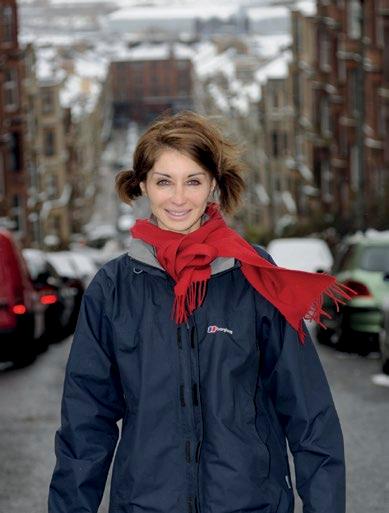

How a daily stroll improves your mental health, boosts your social life and cuts your risk of chronic disease

TwenTy summers ago, Nancy Duguay stood at the side of a football pitch watching her 11-year-old son sprint back and forth, and wished that she had a cigarette.
Duguay, then 39 and a cardiacrehab nurse, was trying to quit after smoking for more than half her life. She’d sneaked her first cigarettes from her parents’ packs as a teen and hadn’t stopped since. With her hands empty as she waited for her son’s practice to end, the urge for a puff gnawed at her.
Behind the field, the heavily forested Sugarloaf Mountain stood guard. As a kid, Duguay and her friends regularly hiked the mountain and picnicked on its peak.
Then an idea struck her: walking instead of smoking. She told another parent that she would be back in time
to pick up her son and then set off for the mountain. “In just my regular trainers, a pair of shorts and a T-shirt,” she remembers.
Duguay’s heart pounded as she climbed, and she stopped often to rest. When she arrived at the top, she took in the view that sweeps over the city and across the river to the rolling hills of the Gaspé Peninsula.
“I just felt so good,” says Duguay. “My natural endorphins kicked in, and the craving was gone.”
Almost every day since, she has gone for a walk—and the habit has changed her life. Not only did she quit smoking, but her resting heart rate dropped from 80 beats per minute to 60. The ritual has given her a lot more, as well: stress relief, mental-health management, community.
“There’s a psychological and
physical need to do it now,” she says. “I want to keep healthy and I want to keep moving.”
A growing body of research confirms what Duguay discovered: walking confers enormous health benefits.
According to a report from the Canadian Academy of Sport and Exercise Medicine, walking for 150 minutes a week can reduce the risk of most major chronic diseases by 25 to 50 per cent. In fact, light to moderate exercise has been found to be more effective than medication during
during the day slept better at night. “We need to start thinking about walking as a healthy activity,” advises Dr Jane Thornton, a family physician in London, Ontario. She advocates for the idea that we consider physical activity as medicine—a philosophy that grew out of personal experience.
Thornton was a shy, sedentary 14-year-old when she signed up for a beginner’s rowing class. While her physical fitness improved, a new social circle opened to her and her grades went up. Thornton went on to become a world-champion rower and represented Canada at the Olympics.
“MOTION IS LOTION.” THEY’RE RIGHT: WALKING REDUCES
rehabilitation after a stroke. For prevention of diabetes and as a secondary treatment of cardiovascular disease, walking is equally as effective as taking drugs.
In 2019, a Journal of Clinical Oncology study reported that a small amount of physical activity—such as taking a brisk walk for 20 minutes or more a day—is linked to a lower risk of seven types of cancer.
Meanwhile, more walking means better sleep, too. In a recent study of middle-aged men and women, the participants who took more steps
A few years after competing in the 2008 Olympics and shortly before retiring from sport, she enrolled in medical school. She was surprised by the lack of information provided to physicians-in-training about the benefits of exercise. “For whatever reason, there just wasn’t any content at all on physical activity,” she says.
In 2014, Thornton started working on a campaign with the Canadian Academy of Sport and Exercise Medicine to get doctors to prescribe physical activity for patients— including walking. “I don’t think it’s a
panacea for everybody, but it is one of the easiest, best solutions we have at our disposal,” she says.
One significant reason that walking is so good for us is fairly straight forward: when we move, our hearts work harder to transport blood to the working muscles and organs. That repeated effort strengthens the heart muscle, making it pump more efficiently at all times, sending blood around the body with fewer beats per minute. Exercise also improves the function of blood vessels, with one analysis reporting that aerobic exercise
embrace the value of walking. At Mount Sinai in Toronto, older patients weren’t always encouraged to get up from bed because of the risk of falling. About ten years ago, that changed. Assisted by doctors, nurses and volunteers, patients are now prompted to walk to the bathroom, explore the hallways and get out of bed to eat their meals.
Since that change, fewer patients require catheters and suffer pressure ulcers. On average, they spend less time in the hospital. “Every day that an older person is in bed, they lose
can improve our vascular health. Walking helps build other muscles, too, especially in the lower body, and improves balance and strength. Physiotherapists like to say, “Motion is lotion.” When our bodies don’t move enough, they stiffen. Ligaments, tendons and muscles tighten when they’re not used, causing pain in joints. For back pain, especially, movement can help. When we walk, we activate the muscles that run along the spine, strengthening them. “Pain and function improve just by putting those muscles into play,” Thornton says. Hospitals have also begun to
five per cent of their physical functioning,” says Dr Samir Sinha, Mount Sinai’s director of geriatrics. “So getting them up and walking can reduce the chance that grandma might not be able to return home.”
Putting one foot in front of the other is equally beneficial for our mental health. For Duguay, walking helped her through some of the toughest periods in her life. When her mother died of cancer, Duguay turned to the mountain to walk through her pain.

“I would cry all the way up the mountain,” she remembers. In this way, walking became her therapy.
According to a 2019 study led by researchers at Harvard University, people with a genetic risk for depression are less likely to struggle with the condition if they exercise— even performing light physical activity like walking.
Walking also reduces the risk of dementia and Alzheimer’s disease. Last year, the World Health Organisation released new guidelines on dementia prevention, and its very top recommendation was to get more exercise.
“We’ve always known that exercise is good for your heart, but we’re now making a connection between exercise and cognitive improvements,” said Dr Saskia
Sivananthan, chief science officer at the Alzheimer Society of Canada.
Although that link isn’t yet fully understood, Sivananthan says there are a number of possible explanations: increased blood flow to the brain increases the organ’s cell growth; physical activity stimulates certain hormones that improve wellbeing and may reduce brain-matter loss linked to cognitive function; and walking might also reduce inflammation in the brain.
Meanwhile, one study from McMaster University has shown that aerobic activity that incorporates intervals of higher-intensity exertion improves memory function. According to Dr Jennifer Heisz, who worked on the research, walking promotes production of a protein, BDNF, that spurs growth of new brain
cells. These cells help us create highfidelity memories—“the type we need everyday to locate our car in a busy parking lot and recognise a friend in a crowd,” she said.
Jim Button, a 56-year-old entrepreneur in Calgary, was diagnosed with kidney cancer in 2014. He underwent successful surgery but, less than two years later, he learned that his cancer was back, had spread and was terminal.
Button knew that exercise would help keep him as healthy as possible. He started walking three miles a day. Before his diagnosis, he’d meet with
business contacts and friends at coffee shops. Now he asks them to join him on a walk. Every day over the last three years that his health has allowed, Button has gone for a walk, all the while expanding the range of his walking partners—he regularly strolls with strangers who reach out to him seeking business advice, or people recently diagnosed with cancer and other illnesses.
“I’ve discovered that not a lot of people go for walks,” Button says. “And when they do, it opens up their mind to be a bit more honest about whatever challenge they would like to talk about.” On some walks, he says, conversation never slows. On others, little is said but much is shared silently.
Inspired by Button’s strolls, Dr Lisa Bélanger—founder of Knight’s Cabin, a Canadian charity for cancer survivors and their supporters— helped found an initiative in Calgary called Walk It Out. The program is like other peer support groups, but participants walk outside while they share their experiences with the disease. “More than in a sit-down, face-to-face meeting, walking seems to allow a conversation to flow naturally,” she says.
Bélanger, who is an expert in behavioural medicine, adds that walking has the power to undo negative thought patterns. “If you’re thinking about a problem and you go for a walk, the activity in your brain changes, and you learn and think better,” she says.
Like Button, New Brunswick’s Nancy Duguay has corralled her community around her daily walks. The more she walked, the more people around her saw the benefits and started doing it, too. Her husband, Roger, began to accompany her on hikes on their holidays. And about seven years after Duguay’s first walk up Sugarloaf Mountain, her sister decided to try it. Now she, too, takes a walk every day, and they often go together. A small community of walkers has formed around them.
“We’ll meet people coming down and say, ‘This was a tough one today. It was really slippery, but boy, you know, it’s worth it.’” n
To get the most out of walking, treat it like a workout, says Calgary-based personal-fitness trainer Korey Samuelson:
n Walk with an upright posture, your head held straight, not looking up or down. Keep your gaze about five metres ahead.
n To move faster, put more bend in your elbows.
n Swing your arms forward and back; moving them across the body isn’t efficient. “Just like sprinting, arm movement is important for strong walking,” says Samuelson.
n When your lead foot lands on the ground, roll from heel to toe. Your footwear should be pliable enough to allow the natural movement across your foot.
n To speed up, increase your strides per minute rather than elongating your strides. More steps per minute means you’ll travel further, faster.
n Use Nordic walking poles to increase your heart rate and burn more calories.
n Intersperse intervals of brisk walking with periods at a slower pace.


Liverpool first became a city in 1880, and thanks to its port, quickly established itself as one of the major capitals of Britain’s Industrial Revolution. Today, it's notable for many reasons. It has borne more number one singles than any other city in the world, is home to Premier League teams Everton and Liverpool and has the second highest number of galleries and museums in the UK (only London has more). But it hasn’t been without its
troubles. Thousands of deaths during the Second World War air raids, endless factory closures bringing mass unemployment in the 1980s and the shock waves of the 1989 Hillsborough Disaster. Through all their triumphs and tragedies, Liverpool remains a proud, defiant city, united by the lyrics to the Gerry and the Pacemakers song, adopted by Liverpool FC and now wrought into the iron gates of the stadium, “You’ll Never Walk Alone.”

“A GOOD PLACE TO WASH YOUR HAIR, LIVERPOOL. GOOD, SOFT WATER”
So said one of Liverpool’s most famous residents, John Lennon, of the city that birthed the most famous band of all time.

CHARLOTTE MARTIN has lived in Liverpool for over 20 years. She owns the tour guiding company Livertours Liverpool and is the most academically qualified Beatles tour guide in the world.
I was born on the Wirral, but both my mum and dad were Scousers, so as soon as I was old enough, I moved to Liverpool. From a very early age, I loved the city’s history. All of my uncles were dock workers, and we’d visit them every Saturday. My dad would take me on all these tours of the docks and the places where he grew up. When I’m giving tours now, I often remember the stories my dad and uncles told me about the strikes in the 1970s and 1980s. They were tough times, but that’s why Scousers are strong, and why we have a sense of humour.
Liverpool is a character in itself—the humour, the people, the wit. When tourists come, they often have this perception of the city as a dark, dank, industrial place and one of the biggest buzzes
of my tours is seeing them going away saying, “oh my God, your city is so beautiful!” Yes, in the Seventies and Eighties we had our ups and downs but it’s not like that anymore.
When Beatlemania hit, you could split the city in half. You had your Beatles fans, and then this other half who couldn’t stand them. Although the boys came back to the city, they signed their contracts in London and set up camp there, and there was a sense of, “oh, they left us”. There was a good reason, because the studios were all in London, and that’s why Cilla Black left us too. But because we’re all wide-eyed and a bit gobby up here, when the Beatles recorded “Love Me Do”, some of the cave-dwellers [hardcore fans so named for The Cavern Club where the Beatles were regular performers] were saying, “don’t buy it so they don’t get to number one and they come back home.”
When they did the northern premiere of A Hard Day’s Night in 1964, the boys
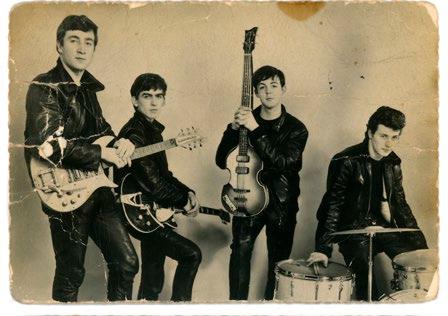
"TOURISTS OFTEN HAVE A PERCEPTION OF THE CITY AS A DARK, DANK PLACE"
were really worried that they didn’t have any fans left in Liverpool. But when they landed in what’s now known as John Lennon Airport, they were brought through departures because there were so many screaming girls in arrivals, and that’s when the penny dropped, and they realised, “we’re going to be alright”.
I remember the Hillsborough Disaster [when compromised crowd safety at Sheffield’s Hillsborough Stadium resulted in a fatal human crush that took 96 lives in April 1989] very well. We were absolutely devastated, and then everything happened with the newspapers calling us liars [The Sun newspaper claimed that the disaster was the result of “hooligan fans”] and it just got worse and worse—it took about 25 years before somebody started to listen. I actually swapped a ticket for the game that day, I was supposed to go with my Uncle Sid, but I didn’t, and it’s just as well. When the news started to come through that people had died, the streets of Liverpool were empty, because everyone was at home listening to the radio and watching the news. It’s all still so raw, but it did bring the city together.
It took quite a bit of time for Liverpool to develop. When I was a kid, it still looked like a bomb site. I remember the


Albert Dock back when it was disused. It was basically a building site in the late 1970s.
It wasn’t until we were named Capital of Culture in 2008 that the investment came, and that was huge. The two biggest things we got were the M&S Bank Arena and the Liverpool One shopping centre. They linked the city centre with the Albert Dock which changed the interface of the city and brought the centre closer to the river.
We’ve gone from strength to strength ever since. You can walk around Liverpool now and just feel it.

ROAG BEST is the half-brother of the original Beatles drummer, Pete Best. He now owns The Magical History Museum, the world's largest singularly owned Beatles collection.
I was born in Liverpool, in my mother’s [Mona Best, owner of the legendary Casbah Coffee Club] house. I’ve said to many people before, if Liverpool could be sawn off the UK and pushed out to sea, I think the people of Liverpool would be happy with that. There’s nowhere else like it. And yes, we’ve had bad press in the past, but

Liverpool is like a lion’s pride. We can criticise and take the mickey out of each other with that Scouser sarcasm, but if someone outside of Liverpool criticises us, then you’ll see the whole city come together. We unite when we come under any sort of attack.
There was a point in the late 1970s and early 1980s where Liverpool was really run down. There was huge unemployment, houses and shops were boarded up and it looked like what it was—a city on the decline. But Liverpool has totally turned itself around and now the city is flourishing. The boom has been long overdue, but I really believe that we’ve made this change for ourselves. It’s been generated by Liverpool, for Liverpool.
Growing up in my house, the Beatles were ever-present, and because of that, it just felt like the norm. When I was 14, Pete gave me his drum kit and at 15,
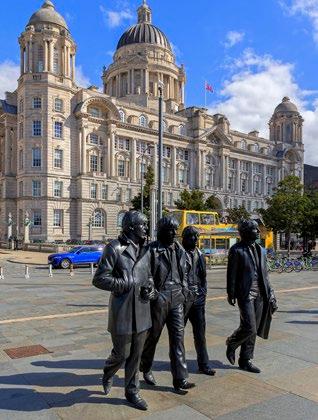
I started playing in local pubs and clubs. I'd have people saying, “Hey, that looks like a 1960s such and such Premier, the Beatles used to play one of them.”
I would say, “Yeah, yeah, it’s this one”, and they’d look at me as if to say, Well what the hell are you doing playing on it?
That would start people saying, “Oh are you Pete’s brother?…I knew your dad, Neil” [Aspinall, long-term Beatles associate, and CEO of Apple Corps] and it would happen so often that the penny started to drop and I realised, Oh my God, this is huge.
The Beatles heritage is something Liverpool is very proud of—we spawned the biggest rock 'n' roll band in popular music history, and they still haven’t been outsold. You can see it everywhere now, but back in the 1980s it was a different story. Steven Van Zandt [known for his role as Silvio in The Sopranos] was in Liverpool last year and said to me, “I came here in the 1980s because I was a Beatles fan, but there was absolutely nothing to indicate that that group had come from this city. I walked around feeling so disappointed—I’d come from New York to Liverpool because of the Beatles and there was nothing here. But you can’t say that now…”
"GROWING UP IN MY HOUSE, THE BEATLES WERE EVERPRESENT"


that I was going to make a cement driveway for her house with a friend of mine, and throughout we’d been mixing the cement using the back of this old metal board. When we’d finished and it was time to throw everything in the skip, I realised that it was actually the original sign for the Casbah Coffee Club.
The idea for my museum, the Magical History Museum, started off back in my childhood. My mother had decided
I asked if I could have it and began asking for other bits too, from my mum’s stuff, my dad’s and Pete’s, and I started collecting. I had so much stuff that about ten years ago, I thought, why not do a museum? And now it’s the largest singularly owned Beatles collection in the world.
n
Mick Harvey is an Australian musician, composer and record producer, best known for his long-term collaborations with Nick Cave, with whom he formed Nick Cave and the Bad Seeds
The UN would be given the power to regulate international law, multinational corporations, investment in scientific research and international human rights with a brief to model such regulation on the basis of the needs of individuals and communities. Without this, we face the ongoing rape of the individual by multi-national corporations in the interests of billionaires. Is that something desirable?
Nation states would be required to nationalise water supply and essential power services. There would be a requirement for universal health care and education to be subsidised to a minimum percentage of GDP. Poorer nations would be assisted until they could be selffinancing in these areas.
A universal basic income would be introduced internationally to deal
with the impending technological revolution in AI, robotics etc. Otherwise, we risk gradual mass unemployment over the next 20-50 years and the growth of a greater divide between the haves and the have-nots. Now, just who wants to see that?
Taxable income would begin above the annually determined average income in any given country. Taxes would be turned into a graduated, flat-rate against gross earnings in all forms. Loopholes for large corporations (apart from illegal activity) would no longer exist.
Trade tariffs would be removed gradually over a period of years or decades after an achievable target had been determined. Africa and other regions which have continued to suffer under fake globalisation processes would finally be brought

to the so-called “level playing field”. Without this, will we ever see an end to the continuation of the colonial economy and the exploitation of Africa and other poorer regions of the world? I doubt it.
All nations would be encouraged to be able to feed their own population as a fundamental principle of domestic security. Monoculture farming and cash crops for export would no longer be permitted unless a basic percentage of national food security was attained or was being seriously targeted.
Every country would have to contribute to repairing the planet
pro-rated to their GDP in order to clean up the oceans, reforest, remove plastic and institute efficient recycling programs.
A 100 per cent worldwide renewable energy target would be aimed at no later than 2050 and seriously enforced by the UN through its regulations of international law. The planet, its people, its biodiversity and its continued existence is doubtful. But you know, maybe it would be better off without us. n
Mick Harvey’s new soundtrack album, Waves of ANZAC / The Journey, is out now on Mute
If you’re looking for ways to boost your finances, you might be surprised to discover the hidden savings stored within the four walls of your home.
If you’re looking for ways to boost your finances, you might be surprised to discover the hidden savings stored within the four walls of your home.
If you're a homeowner aged 55 and over, you could be eligible to take advantage of your property wealth and unlock tax-free cash from your home.
If you're a homeowner aged 55 and over, you could be eligible to take advantage of your property wealth and unlock tax-free cash from your home.
If you are thinking about releasing your equity to help boost your savings this year, then it is important to get the facts.
If you are thinking about releasing your equity to help boost your savings this year, then it is important to get the facts.
We know that many of our readers are looking for answers to managing their retirement – something that’s only getting trickier to navigate. Equity release might be the solution you’re looking for. To help you, we’ve created a straightforward introduction to equity release that should answer all the big questions you might have.
We know that many of our readers are looking for answers to managing their retirement – something that’s only getting trickier to navigate. Equity release might be the solution you’re looking for. To help you, we’ve created a straightforward introduction to equity release that should answer all the big questions you might have.
Cover a financial shortfall
Cover a financial shortfall
Pay off an existing mortgage
Pay off an existing mortgage
Help a loved one in need
Help a loved one in need
This is a Lifetime Mortgage which may impact the value of your estate and could affect your entitlement to means tested benefits. To understand the features and risks, ask for a personalised illustration. Reader’s Digest Equity Release is a trading style of Responsible Life Limited. Only if your case completes will Responsible Life Limited charge an advice fee, currently not exceeding £1,490.
This is a Lifetime Mortgage which may impact the value of your estate and could affect your entitlement to means tested benefits. To understand the features and risks, ask for a personalised illustration. Reader’s Digest Equity Release is a trading style of Responsible Life Limited. Only if your case completes will Responsible Life Limited charge an advice fee, currently not exceeding £1,490.
“
“ For your FREE GUIDE call us now: - November 0800
Reassuring, speedy and painless!
Reassuring, speedy and painless!
“From beginning to end, the whole process was easy, quick and professional, with clear information. All our questions were answered fully, which helped us choose the right product with ease.”
“From beginning to end, the whole process was easy, quick and professional, with clear information. All our questions were answered fully, which helped us choose the right product with ease.”
For your FREE GUIDE call us now: - November
-November 2019, Mrs Silvester
-November 2019, Mrs Silvester




















or visit: www.readersdigest.co.uk/er2












This year marks the 75th anniversary of the atomic bombings of Hiroshima and Nagasaki, yet the threat of a nuclear war still hangs over humanity almost a century later…
By Chris Menon
“I STILL VIVIDLY REMEMBER THAT MORNING. At 8:15, I saw a blinding bluish-white flash from the window. I remember having the sensation of floating in the air. As I regained consciousness in the silence and darkness, I found myself pinned by the collapsed building. I began to hear my classmates’ faint cries: ‘Mother, help me. God, help me.’
“Then, suddenly, I felt hands touching my left shoulder, and heard a man saying: ‘Don’t give up! Keep pushing! I am trying to free you. See the light coming through that opening? Crawl towards it as quickly as you can.’ As I crawled out, the ruins were on fire. Most of my classmates in that building were burned alive. I saw all around me utter, unimaginable devastation.
“Processions of ghostly figures shuffled by. Grotesquely wounded people, they were bleeding, burnt, blackened and swollen. Parts of their bodies were missing. Flesh and skin hung from their bones. Some with their eyeballs hanging in their hands. Some with their bellies burst open, their intestines hanging out. The foul stench of burnt human flesh filled the air.”

This is the personal testimony of Setsuko Thurlow, who as a 13-year-old survived the US dropping of the first atomic bomb on Hiroshima. That act on August 6, 1945, killed an estimated 146,000 men, women and children.
In the years since, the world has lived under the shadow of a nuclear war that could effectively destroy humanity, whether by accident or design. The threat of a nuclear war is particularly acute today: the weapons that exist now are much more powerful than those deployed in 1945—a Hiroshima-type bomb would now be considered small. There are also many more of them (roughly 13,500), held by nine nuclear countries (the US, Russia, the UK, France, China, India, Pakistan, Israel and North Korea).
Although agreements between
the US and Russia brought down the numbers of nuclear weapons from their peak in the 1980s, the world could soon be faced with a nuclear arms race as all the nuclear powers modernise and expand their arsenals, while some countries that don’t have them seek to obtain them.
The increased risks of nuclear war have been recognised by those leaders and scientists responsible for the Doomsday Clock, symbolically, putting it at 100 seconds to midnight [See Box 1].
Noam Chomsky, the world renowned philosopher, linguist and political activist told Reader’s Digest: “It moved closer to midnight than it’s been since its first setting in 1947. The threat of nuclear war is one reason. Last August, President Trump dismantled the Reagan-Gorbachev INF Treaty and immediately tested weapons that violate the treaty. He has indicated that he may not sign the New Start Treaty, which essentially terminates the arms control regime that has significantly lessened the dire threat of nuclear war. Diplomacy, the only hope, has increasingly been sidelined in favour of provocation and force. Unless this disastrous course is reversed, not just on the part of the world-dominant power, prospects for survival are dim.”
Chomsky's concerns over the prospects for the world surviving might appear overblown to those
Maintained since 1947 by members of the Bulletin of Atomic Scientists, the Doomsday Clock is a metaphor for threats to humanity from unchecked scientific and technical advances. The Clock represents the hypothetical global catastrophe as "midnight" and the Bulletin's opinion on how close the world is to a global catastrophe as a number of "minutes" to midnight. The main factors influencing the Clock are nuclear risk and climate change. The Clock's original setting in 1947 was seven minutes to midnight.
In January 2020, the hands were moved from 2 minutes to 100 seconds to midnight. It is now closer to midnight than at any point since its creation in 1947.
A statement issued by the Bulletin of the Atomic Scientists explains: “Humanity continues to face two simultaneous existential dangers— nuclear war and climate change— that are compounded by a threat multiplier, cyber-enabled information warfare, that undercuts society’s ability to respond. The international security situation is dire, not just because these threats exist, but because world leaders have allowed the international political infrastructure for managing them to erode.”

unfamiliar with the number of close calls that have already taken place. Yet it is well documented that on many occasions the world has come chillingly close to a global nuclear armageddon between the US and Russia, while lesser "accidents" abound. Kate Hudson, General Secretary of the Campaign for Nuclear Disarmament, confirms: “Over the past 75 years nuclear weapons have been used twice in war and dozens of nuclear accidents have brought the world to the brink of annihilation.” [See box 2]
Climate scientists have modelled that even just a one-sided, first strike by either Russia or the US would be likely to produce a pyrrhic victory in the form of a "nuclear winter," with global temperatures dropping below freezing over land, even in summer, for a decade.
Alan Robock, the US climatologist who is currently Distinguished Professor in the Department of Environmental Sciences at Rutgers University, explains: “The resulting climate changes, triggered by smoke, would be so damaging to food and water supplies that infrastructure breakdown would assure starvation in the attacking country as well as the rest of the world. Call it selfassured destruction, or SAD.”
Even a regional nuclear war would prove calamitous. For example, according to research by Robock and other climatologists,

Noam Chomsky
“The proliferation of nuclear weapons indicates that humanity still hasn't grappled with the existential threat they pose”
a war between India and Pakistan that detonated approximately 290 nuclear weapons of varying yields, could immediately kill between 50 million and 125 million people in both countries. It would also cause huge global climatic effects, as smoke and debris would rise up to the upper atmosphere and block the sun, cooling the planet’s surface by several degrees for about five years.
The resultant reduction in crop yields would then lead to famine affecting many millions, perhaps even billions.
Given that even first use of nuclear weapons is likely to be suicidal for the user, Hudson clearly has a point when she says: “the proliferation of nuclear weapons indicates that humanity still hasn’t grappled with the unique existential threat nuclear weapons pose. Disarmament really is the only way to secure our survival.”
Fortunately, there are some who recognise the threat posed by nuclear arsenals and one very encouraging landmark event occurred with the adoption of the UN Treaty on the Prohibition of Nuclear Weapons (TPNW) on July 7, 2017. On that day 122 countries took a critical step towards making that nuclear-weapon-free future a reality.
Beatrice Fihn is executive director of the International Campaign to Abolish Nuclear Weapons (ICAN) which won the 2017 Nobel Peace Prize for helping to pass the TPNW. In an exclusive interview she explained its significance: “It marked the moment the world decided that these weapons do not belong in an international system based on rule of law. It's one of those historic achievements, together with the bans of
biological
weapons, chemical weapons, landmines and cluster munitions.”
For those countries that are
party to it, the treaty prohibits the development, testing, production, stockpiling, stationing, transfer, use and threat of use of nuclear weapons. For any nuclear armed state joining the treaty, it provides for a time-bound framework for negotiations leading to the verified and irreversible elimination of its nuclear weapons programme.
In 1983 a satellite early-warning system near Moscow reported the launch of one American Minuteman missile. Soon after, it reported that five missiles had been launched. Convinced that a real American offensive would involve many more missiles, Lieutenant Colonel Stanislav Petrov of the Soviet Air Defence Forces refused to acknowledge the threat as legitimate and continued to convince his superiors that it was a false alarm until this could be confirmed. Thankfully, Stanislav Petrov helped prevent the outbreak of a devastating nuclear war that would have destroyed humanity.

In order to come into effect, signature and ratification by at least 50 countries is required. As of November 25, 2019, although 80 states have signed it, only 34 states have ratified the treaty. Partly, this is because of bureaucratic delays as it can easily take up to two years for the domestic legislation to ensure national law is compliant with the TPNW. Sadly though, the nine countries generally recognised as possessing nuclear weapons were noticeably absent from the negotiations, as were most members of NATO. Japan, despite being the victim of atomic attacks in 1945, also boycotted the meeting.
Fihn is perplexed by this, as she explains: “The TPNW is a multilateral treaty that allows for a government to negotiate the exact process and timeline of its disarmament of nuclear weapons. So if nuclear armed states want to proceed with multilateral disarmament, they can do so under the treaty.”
US-based Ploughshares Fund, which invests to promote nuclear disarmament, estimates that the nine nuclear states are planning to spend at least US$1trillion modernising their nuclear weapons over the next decade, with the US making up 60 per cent of that and the UK five per cent. Tom Collins, its Director of Policy, admits: “I do not think the US is serious about eliminating nuclear weapons. Obama supported

the eventual goal of elimination, but wound up supporting a complete rebuilding of the arsenal and rejecting the TPNW. Trump has no intention of moving toward zero, and wants to build up US forces.”
Yet, Collins believes UK moral leadership could make a world of difference. “The UK could and should be the first nuclear power to sign the TPNW. The UK does not need nuclear weapons (it is under the US nuclear umbrella) and could gain international prestige by being a leading advocate for elimination.”
It’s a huge role that Kate Hudson believes Britain must take on.
“If Britain cancelled its Trident replacement scheme, our present nuclear weapons system would retire in about ten years’ time. We should use those ten years to sign up to the UN Treaty on the Prohibition
of Nuclear Weapons and become a serious player on the world stage for disarmament and diplomacy.”
Collins urges citizens concerned about the threat posed by nuclear weapons to call on their governments to sign the TPNW and move to eliminate nuclear weapons. In addition, Robock advises: “Support leaders who make getting rid of nuclear weapons a priority. ICAN is a coalition of many organisations, so you cannot join, but join your local organisations, such as CND.”
Reversing the steady drift towards another nuclear arms race that further increases the likelihood of eventual annihilation won’t be easy but it is possible. Chomsky envisages it will take “something like the major popular campaigns of earlier years to reduce the terrible threats and rid us of this curse.” n

How do you stack your bookshelves? Do you organise by theme, colour, size, chronology? We explore what the art of the shelf says about the reader
By Lottie Fyfe

Whenever I am invited to somebody’s house for the first time, I am compelled by some strange and undeniable magnetism to inspect their bookshelves. Part of the draw might be that what we keep on our shelves is to some extent a reflection of who we are, our personal tastes and preferences— the contents of a bookshelf tell the story of a life. And we certainly get attached to our books in a way we don’t with any other type of possession: Marie Kondo sparked an online furore after it was reported that she suggested clients should
pare down their book collections (a claim that was later revealed to be untrue). Patty Morrissey, a certified KonMari decluttering consultant, is keen to stress that the ethos behind the method is not minimalism, but a conscious decision about how you relate to your possessions: "The things that you're surrounding yourself with, and it's definitely true for books, should reflect the person you’re becoming. Everything reflects an intention that you have." And these intentions are often reflected on our bookshelves in the form of the "to be read" pile.
Tom Cox, author of ten books(most recently Help the Witch, a collection of stories about folklore and landscape), says that his own extensive collection is partly a reflection of his ambitions. "I very carefully curate what I want to read, because I’m thinking about what’s going to expand my horizons as a writer." So there’s no denying that what we choose to display to the world in the form of our reading material says something about us. But is there also something about the way we stack our shelves that is just as important?
My own shelves are a sort of roadmap through my life, telling a chronological tale. First up come my favourite childhood reads, which I return to now and again for comfort, like The Chronicles of Narnia, Watership Down, Malory Towers and His Dark Materials. The collection then graduates on to teenage rites of passage and the dystopian novels I read in school—Nineteen EightyFour, The Handmaid’s Tale and A Clockwork Orange. Finally, we emerge from full-time education and enter the real world: a career in publishing is a sure-fire way to accumulate a lot of books, and this section is a testament to a professional life, from the first heady days of work experience to the present, the spine colophons chopping and changing with each job move.
If you pointed to my shelves at random, I could name the year I acquired the book, where I was working, and probably where I was living at the time. I thought I was alone in this, but Ben Critchley, an antiquarian bookseller and collector in Edinburgh, agrees that our shelves tell the story of our life. "If I disappeared tomorrow and people wanted to know what I was like, they could look at my bookshelf and get some idea," he says.
His personal shelves house categories like "Arthurian Legend" and the fondly named "Fiction Without Integrity", but spill over into

"MY OWN SHELVES ARE A SORT OF ROADMAP THROUGH MY LIFE, TELLING A CHRONOLOGICAL TALE"
overflow piles that follow a similar chronological system.
"Books are records," he says.
"I remember buying a lot of this stuff: where I was and what I was doing. It means I’ve a fairly good idea of when it arrived in the pile and because of that I could give you a reasonable stab at where it is."
"MOST PURISTS BAULK AT THE IDEA OF BOOKS BEING USED AS A TOOL OF INTERIOR DESIGN"
If arranging one’s books by some sort of indecipherable chronological system is rare and a bit oddball, there are plenty out there who are particular about the curation of their collections in other ways. Cox’s extensive collection caught my eye online for its photogenic qualities. It’s a collector’s library, mostly grouped by publisher—orange-spined Penguins sit together alongside Penguin Modern Classics, then there are shelves for his collection of New Naturalists, Picadors and Viragos—and it’s clear he takes pride in the way his books are displayed. "The Viragos particularly are a very aesthetically pleasing corner," he says. "I’ve become someone who’s interested in the look of books as well as reading them." And he’s certainly not the only one who feels this way: books have an unusual aesthetic power, becoming a part of the décor of a room in their own
right. I’ve lost count of the number of social media posts I’ve seen depicting bookshelves arranged by the colour of their spines, regardless of size, format, author or genre. But purists often seem to baulk at the idea of books being used as a design focus—indeed in 2018, interior designer Lauren Coleman sparked a torrent of vitriolic abuse on social media by revealing that she arranged her shelves with the spines facing inwards to present a neutral colour palette, proving that emotion on the subject of books, and how they should look, runs high.

It’s not just on our own shelves that we love to explore our fascination with noteworthy book displays. Nina Freudenberger’s 2019 book Bibliostyle: How We Live at Home with Books explores some of the world’s most eclectic and unusual libraries, featuring homes with books on every flat surface, working reference collections, floor-to-ceiling shelves with rolling ladders, piles of books stacked by size, and much more. The resounding message is the power of each collection to tell a story.
"Book collections tell so much about an individual; it is such an easy way to get to know about their hopes, dreams, ambitions and interests," she says. And a big part of that story is that how we arrange our books, and interact with them,


is such a personal thing, unique to each individual. "We found so many different formats of how people lived with their book collections, and each one was beautiful. Some wanted to be surrounded by their books in every room, others had them on shelves, behind glass or simply lining their floors. Each home had a story to tell through the way they lived with their books."
Indeed, there are some highprofile libraries that tell their particular stories in a much more visible way. The Wing, an exclusive women-only member’s club,
which last year opened a branch in London, places a particular focus on its carefully curated and colour-coordinated library spaces dedicated to titles by or about women. Similarly, Karl Lagerfeld was renowned for his unusual library: his books are famously stacked horizontally rather than vertically—a bold statement and fitting aesthetic from a pioneering fashion designer.
But I can’t help but be struck by two instances in particular of large and public book collections that seem to be broadcasting a message in the way they’re shelved. The King’s Library Tower at the British

Library in London’s St Pancras houses the personal collection of King George III. It was unusually extensive for its time, covering everything from classics and religion to everyday concerns such as construction and farming, and the tower itself is made of glass, so its contents are visible to the library users outside. Adrian Edwards, Head of Printed Heritage Collections, explains the intentions of the tower’s designer, Colin St John Wilson. "He was very interested in different communities of library users being aware of and engaging with one another." So the fact that the books are visible, and central, is no accident. "The British Library is full of people working with old books,
but it’s also full of people working with data sets, and for them to see a beautiful collection of old books every day, and see them being used— you’re getting that awareness that people are still using the books for their work. And putting antiquarian books solidly in the middle reminds people that are working with science and technology about older things, so it’s quite nice, that reminder."
It seems to me that the tower is the perfect embodiment of what the collection it contains represents: a central repository of knowledge; protected, but accessible to all.
Finally, we embark on another journey, across London, to Marylebone High Street. Our

destination is a bookshop: Daunt Books, with a painted front and lights glowing from the windows, welcoming you inside. Visiting this place is a form of escapism in its own right, akin to the experience of being lost in the winding shelves of a good second-hand bookshop, or even your local library, and finding buried treasure amongst the dusty stacks. Here, rather unusually, fiction and non-fiction live side by side on beautiful wooden shelving in a large gallery, with titles arranged by specific criteria: A-Z, by country. Wandering around the shop, browsing, is a voyage around the world all on its own, and is utter bliss. The message here, to me at least, is clear: come in, plot a course,
set sail, and lose yourself amongst our shelves.
So while it’s always been the case that what we read says something about our preferences and interests, perhaps we are also coming alive to the idea that how we stack our shelves might also convey a message about ourselves as individuals, or indeed something wider and more universal. From the jumbled pile of books on your bedside table to your painstakingly colourcoordinated shelves; from designer libraries intended to impress to the regimented systems of a public collection, to the sweeping

"WANDERING AROUND THE SHOP, BROWSING, IS A VOYAGE AROUND THE WORLD ALL ON ITS OWN. BLISS"
grandeur of the most beautiful and photographed bookshops in the world, whether we're conscious of it or not, our book collections are making statements, broadcasting messages and exclaiming philosophies, telling a story before a single page has been turned. n


 Main: Happo One, Hakuba, Nagano; (Insets) A shrine and waterfall near Takayama, Gifu
Main: Happo One, Hakuba, Nagano; (Insets) A shrine and waterfall near Takayama, Gifu
“Hey, there’s a waterfall up there, shall we take a look?” I ask when I see a signpost on the side of the road. My family and I are driving along Route 158, one of Japan’s national highways, headed for Hakuba located in the Japanese Alps in Nagano prefecture, on Honshu, the main island of Japan.
At first glance, a self-driving holiday in bustling Japan might seem too much to conquer, but Diane Godley found having a car gave her and her family the freedom to explore treasures far from the usual tourist sights surrounded by lush mountain forests, and just as we were approaching a corner, without warning, we were forced to stop. Wildlife on the road. Now that’s something we didn’t expect to see in Japan.
“Do you think it’s a goat?” I ask.
“No, maybe a deer,” says someone in the back seat.
“Why not?,” was the general consensus. After all, we were not in a hurry. We had less than 93 miles to drive to our alpine destination, and the mid-October autumn weather was overcast and drizzling lightly.
We turned onto the side road
The four of us couldn’t agree what it was we were looking at before it high-tailed into the forest. What we did agree on was that it was a particularly unusual, dare I say ugly, specimen of nature.
PHOTOS: DIANE GODLEY
We picked up our hire car in Takayama—a historic village in the Gifu Prefecture and the gateway to the Japanese Alps—on the day a typhoon was to hit Japan’s main island of Honshu. We’d spent the previous day wandering through its narrow streets. Lined with wooden merchants’ houses and latticed windows, the buildings date back to the Edo Period (16031868) and are safeguarded against future development by a Traditional Buildings Preservation Area law.
Many of these historic houses have been converted into museums and shops, which sell all manner of handicrafts and delicacies from the local Hida area, such as gyuuman (beef in soft dough buns); mitarashi dango (gelatinous rice formed into little round dumplings); matcha (green tea) ice cream, sake and craft beer. The most famous food from this area is Hida beef, a breed of Japanese black cattle farmed in the clean mountainous region.

Traditionally, strips of the marbled meat are cooked over a flame at your table, at around the princely sum of £40 for 100 grams.
Our hire car was a small (yet welcoming) metal box on wheels. Most Japanese cars seemed to be in this cube style (no doubt to fit on the narrow roads), and although ours looked small from the outside, there was plenty of room for my husband and I and our two lanky teenagers. The boot was another story. Fortunately for us, we had this in mind when we packed back in Australia, exchanging a couple of large cases for four carry-on-sized bags. These fitted perfectly and gave us a little extra room to buy a bag for all our souvenirs.
As our friends and family back home kept a nervous vigil on reports of the escalating scale of the typhoon, it heralded its arrival in Takayama with just a bit of drizzle. However, the rain didn’t dampen our spirits. As we had a car we could drive to some of the attractions on

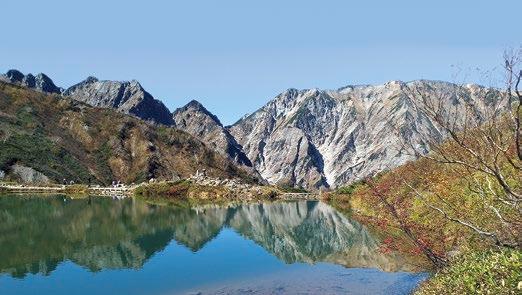
the outskirts of town and stay dry, plus we’d just had ten glorious hot days in the south of Honshu.
The cancellation of the morning markets along the Miyagawa River should have given us some indication of how seriously the Japanese take their weather warnings. We headed out of town to the Hida Folk Village, but it was closed. Museum Hida, closed. Even the Teddy Bear Eco Village had shut up shop. Everything was quiet. In fact, there were no locals on the street at all, there were only Western tourists like us wondering whether we should be more worried. So we spent the afternoon driving through the narrow streets exploring. Sometimes the roads led to a shrine, sometimes dead ends, and once the start of a forest walk where we saw a flyer warning tourists, in four languages, that bears had been seen in the these woods.
Bears?
In Japan?
How did we not know that there
was still wildlife roaming around pockets of Japanese wilderness?
Apart from strong winds overnight, we woke to find Takayama was pretty much untouched by the typhoon, although unfortunately other areas of Japan weren’t so lucky. By the following day the rain had set in. One of the items on my bucket list while in the Japanese Alps was to visit an onsen (hot spring), so we couldn’t think of a better outing on a drizzly day than to head up into the mountains, where onsens are aplenty.
There are two ways to drive through the mountains in Japan: the high road (the longer, scenic route), or the low road (through tunnels, the quick way). With low-lying clouds, on this occasion we took the quick route, as visibility was getting poorer the higher we drove.
The first of our many hot spring experiences was an open-air onsen located on the side of a river and


ensconced under a pedestrian bridge. Being a public onsen, there was only an honesty box to collect our money. And, as this was a rather misty morning, we had it all to ourselves. As beautiful as the location was, the water temperature was a little too cold and we soon got dressed to go looking for a more established facility.
We found another onsen about ten minutes up the road. It had separate bathing areas for men and women and a variety of pools at different temperatures where we soaked up the mineral salts for as long as we could handle within the hot water. With the exception of our 16-year-old son, who found the nudity too confronting, we all loved the experience and vowed to repeat it as many times as we could while in the alps. At around £8, this is one of the few things in Japan that is very affordable.

On our way back to Takayama we saw a sign for a Bear Ranch. Piqued by the sign we’d seen the day before fluttering in the wind, we couldn’t resist taking a look. We paid our entry fee and bought a bag of dried fruit to feed the bears.
Like other Asiatic black bears, the Japanese black bear (Ursus thibetanus japonicus) has a pale yellow crescent marking on its chest. Standing between three to five feet and weighing up to 265 pounds, it is considered small among bear species. Extinct in many regions of Japan due to the rapid loss of habitat after the Second World War, the population of black bears on Honshu is considered healthy.
No road trip is complete without a pit stop. Unlike anywhere else I’ve travelled in the world, you can be assured wherever you stop in Japan
the toilets will be immaculately clean. It's not going too far to say that stopping at a public convenience in Japan is a pleasure. There's warm water to wash your nether regions, many with airdrying facilities, plus never once did I find a toilet roll holder empty.
The next day we headed further into the alps to our next destination: Hakuba, the village that hosted the Japan 1998 Winter Olympics. We figured it would only take a couple of hours to get there so we made regular sightseeing stops along the way—the first being the waterfall where we saw the odd creature on the road, which we later discovered was a Japanese serow, or a, “Japanese goat-antelope”.
If we’d been driving in Australia, the sign to the waterfall would have been a mere blur as we sped past. In Japan, however, there is a very good reason why we didn’t miss the turn off and why we avoided hitting the serow; the speed limit. At 31mph on regional roads and 25mph in villages (50mph on motorways), you can enjoy a leisurely drive through the provinces and visit out-ofthe-way places not on shinkansen (bullet train) routes. Thanks to this year’s Summer Olympics, a lot of road signs are now written in English as well as Japanese. They also drive on the left. In fact, the hardest part about driving in Japan is keeping under the speed limit!
Although still misty, the views of the mountains were spectacular; forested hillsides in burnt autumn hues threaded with long wispy clouds. They looked just like a Japanese landscape painting. We took a short trek along a river and stopped at Asahi Dam, but the goal for the day was to visit Kamikochi, a nature reserve in the Azusa River Valley said to offer Japan’s most spectacular mountain scenery. Unfortunately, the drizzle had turned to steady rain and clouds were very low by the time we got there, so we opted to press on and visit one of the many free foot spas dotted around this part of the country instead.
We arrived at our apartment, Hakuba Ski Condos, in a fog of cloud. But according to the weather forecast, the following day looked favourable and we told Bob, the friendly Canadian manager, of our intentions to get up early to walk up the most popular mountain, Happo One (pronounced On-ay). The next morning, we had two surprises in store for us; a view of the mountain from our living room, and a picnic basket at our front door with all the ingredients to make waffles for breakfast. We were ecstatic! We’d been in Japan for nearly two weeks and, frankly, we were hankering after Western food. Our moods lifted.
It took one gondola and two ski lifts to get to the start of the walking track for Happo One. We were starting at an altitude of 1,800 metres. Today’s goal was to walk to Happo-ike Pond at 2,080 metres. Anyone attempting to trek further was required to have proper mountaineering equipment.
With the Japanese trekkers decked out in the latest hiking gear and boots, and bells jingling on their backpacks to scare away bears, we felt like amateurs. For me, the 280-metre trek to the pond was tough going. Not only did the slightly thin air make it hard on my lungs, but loose rocks underfoot where the footpaths ended made it hard work—less so for my teens.
Much like everyone else, we stopped at Happo-ike Pond to take photos of the three mountain peaks reflected in the mirrorlike water. The clouds were well beneath us and the sun bright and high, creating the perfect setting to photograph the mountains soaring nearly 3000 metres into the sky.
This is where I left my gang, who had decided to press on up the mountain—without one scrap of mountaineering gear between them, but with all the food. I walked back at my own leisurely pace, ending a hard day’s climb with a bowl of ramen and a soak in an onsen. n
Driving in Japan is quite straightforward: they drive on the left-hand side and from a leisurely 25mph in villages to 50mph on motorways.
Plus signage is clear and easy to understand.
• There are numerous car hire companies in Japan, both international and local (Toyota Rentacar, Nippon Rentacar, Orix Rentacar, Times Car Rental, Nissan Rentacar and Ekiren). All charge similar prices.
We chose Toyota (rent.toyota.co.jp) because we weren’t required to provide credit card details up front, and it was easy to organise different locations for car pick-up and drop-off.
• We recommend organising your car hire before you leave, which can be done up to three months before your trip.
• To drive in Japan you’ll need an International Driving Permit.

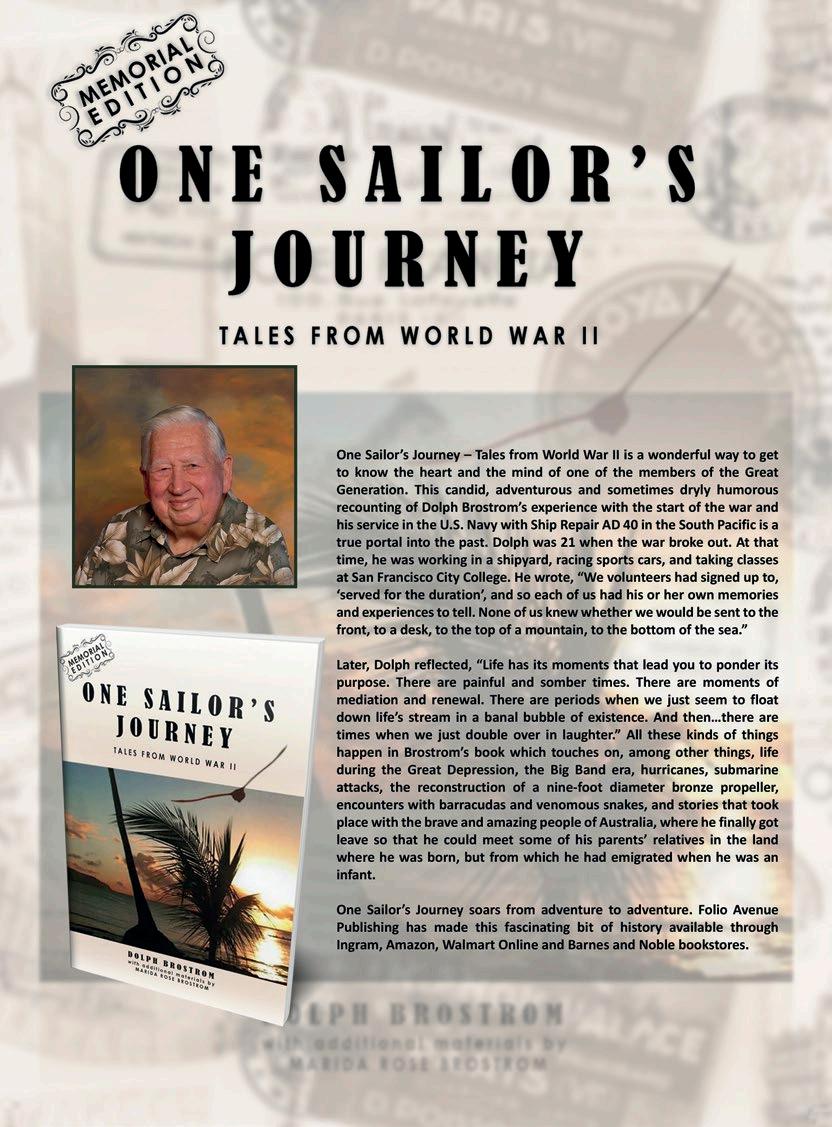
My Great Escape:
Our reader Mark Whitaker from West Yorkshire ponders the history and charming idiosyncrasies of “the land of the eagles”, Albania
The only people who don’t call their country Albania are the Albanians themselves. Their word for their beautiful and rugged land means “Home of Eagles” and it’s pronounced how it looks, Shkipëria.
My wife and I were enthralled by the country—its startling natural beauty, the friendliness of its people, and by their efforts to come to terms with their uniquely traumatic recent history as Europe’s answer to North Korea.


Our first stop was in the “Albanian Riviera.” Our small terrace looked out over an unkempt orchard of plums, walnuts, apples and quince to the hills and the sea, with a glimpse of northern Corfu in the distance.
Our next was the ancient Ottoman town of Gjirokastër. Recognised by Unesco as a world heritage site,



it clings to a steep hillside with vertiginous cobbled streets and closely packed houses.
Near the main square, a modest door leads to a complex of tunnels designed as a safe haven for the regime’s elite in the event of Albania being attacked by nuclear weapons— not a place for the claustrophobic.
We then headed into deep countryside. The road snaked along the Gramos mountains that form the border between Albania and Greece. Forests gave way to high mountain pastures, and farmers bounced along on small donkeys. Then down to the plain, past the old Cathedral city of Korçë, to our destination, Pogradec, on the shores of the great Lake Ohrid.
Pogradec is an evening promenade town where residents spend summer evenings walking up and down next to the water.
Our last drive was back to the capital Tirana, and we decided to devote our last days to Hoxhatourism, learning what we could from museums and art galleries.
Albania’s path away from its isolationist past is to seek membership of the EU, though it is far from the front of the queue. We could only feel the sad irony when Albanians expressed their hopes for the future.
“We’re just waiting for Europe.” n
Tell us about your favourite holiday (send a photo too) and if we print it we’ll pay £50. Email excerpts@readersdigest.co.uk
In our new travel series, Richard Mellor looks at some of the world’s most beloved cities and destinations off the beaten track within them
Paris abounds with stellar views, from the Pompidou’s rooftop restaurant to the highest platform of the Eiffel Tower. Much more secret, however, is the vista from atop Butte Bergeyre, a sleepy hilltop village in the northeasterly 19th arrondissement near Parc des Buttes Chaumont.
At its 100m-high pinnacle, the buildings break to offer an unbroken gaze to Montmartre, with the famous white Sacré-Cœur basilica glinting in the sun or, should you time it right, the sunset.
Better yet, that’s only part of Butte Bergeyre’s bucolic spell. Look down, below said view, and you’ll notice one of Paris’s last-surviving vineyards. Owned by the city, it produces barely more than 100 bottles per year, including a rosé that one can sample during midSeptember’s Fête des Jardins open day.
Otherwise, the vineyard is closed but not the community vegetable garden next door, where tracks weave between log-lined plots.
The surrounding few streets are cobbled and mostly traffic-free. Some of the old houses are swathed in creepers as others peel attractively. A delicious, trapped-in-time vibe pervades, distinct to the rest of Paris.
Sound good? There are three ways ignore Google Maps, which alleges a fourth up to Butte Bergeyre: via the snaking Rue George Lardennois, perhaps using some steps (called Rue Michel Tagrine) to cut off one switchback, or via stone staircases from either Avenue Simon Bolivar or Rue Manin, which runs alongside Parc des Buttes Chaumont. The nearest Metro stations are Bolivar, Buttes Chaumont and Colonel Fabien. n


Shopping around for cheaper energy is too much of a fuss. Let’s be honest, even if you’re the savviest of comparisonsite users, you can still be left with the lingering uncertainty that you might be getting ripped off. Well now you can save time and money without doing a thing.
Look After My Bills is a revolutionary and free energy auto-switching service which takes the hassle out of your energy bills. They take all the tedious bits of doing bills and leave you with the cream of the crop — a cheap deal, a reliable energy company and peace of mind every year.
Their expert team manage the whole process for you, from running the comparison, to sourcing a deal and even the switch itself. It will save you from spending hours of shopping around on comparison sites for the best energy deal — as well as money of course! In fact, members of the service save on average £253 a year on their bills.
When that deal ends, Look After My Bills automatically moves you to a new
deal so you never have the hassle of remembering to switch yourself, and are always saving and never overpaying. You can be safe in the knowledge that you’re on a cheap energy deal every year. Sign up once, get great energy deals forever Auto-switching is the simplest way to save money on your energy every year. It’s the modern way to do bills, without the headache and hassle of comparison sites. It’s the ‘why didn’t we do this before?’ moment we’ve been waiting for!
So why not save yourself precious time and money and let Look After My Bills manage it all for you? n
Join for free in just two minutes — call today on 020 3950 1166 and quote Reader’s Digest or visit lookaftermybills.com/digest
There’s never been a better time to get to grips with your spending. I’ve pulled together this list of easy actions you can take that’ll save you hundreds, if not thousands, of pounds every year
It might be that some of these tasks will have to wait a little longer, especially if you’re currently under contract. But don’t ignore them. Find out when the contract ends and make a note of this date in your diary so you can come back to this article and get those savings too.

Andy Webb is a personal finance journalist and runs the award-winning money blog, Be Clever With Your Cash
1 Switch your energy
Head to a comparison site. I like to use Money Saving Expert’s Cheap Energy Club . Enter how much energy you used in the last year (it’ll be on your bill) and click to see what other energy providers are charging.
The process should take less than ten minutes, and you should be moved to the new company in three or four weeks. You won’t see any difference to the gas and electricity you get, and there won’t be any break in your connection.
2 Consider a water meter
You can’t switch water companies, but in England and Wales you can ask for a water meter. The rule of thumb is that if there are fewer people in the house than bedrooms you’ll likely pay less with a meter.
However there are calculators online that will give you a more accurate picture. If you’re not online, call your water company and see if they will go through it with you on the phone.
3 Turn off your pay TV services
If you get your TV via Sky, Virgin, TalkTalk or BT you can get the same channels for less through Sky’s much cheaper NOW TV . Or you can choose instead to take advantage of all the content
SOME OF THE BEST DEALS ARE FOR NEW CUSTOMERS YOU COULD EASILY REDUCE YOUR BILL BY HUNDREDS OF POUNDS
available on Netflix , Amazon Prime Video and Disney+ .
These subscriptions are all month-by-month, so you can stop them whenever you want and switch between them. There are also regular deals to bring the price down further.
There are a couple of things to be aware of though. First, these require you to have a decent broadband connection, and you might need to buy a cheap “smart stick” so you can access them on your TV. You also won’t be able to record live TV, though everything is available on-demand.
4 Boost your broadband and landline
Another service you should look at moving is your broadband and home phone line. Some of the best deals are for new customers. Combine these offers with cashback
and you could easily reduce your bill by hundreds of pounds.
I know for those who use their landline this is a worry, but it’s possible to keep it. However if you have set an email address with the provider (for example, @btinternet. com), you will lose access to this. You’ll need to set up a new one with the likes of Gmail or Outlook and let your contacts know.
There are actually only four mobile phone networks—EE, Vodafone, Three and O2. All the other networks you see are virtual and use one of the main four. This means if you’re with one of the big four you know you can get signal, so you’ll still be able to get exactly the same service from another brand and it’ll likely be cheaper.
Plus, the cheapest way to get your minutes, data and text messages is via something called SIM-only. This is where you separate your allowance from the cost of your handset.
If you do need a new phone then you’re better off buying it outright from a different shop. There are 0% finance deals available from the likes of Apple and Samsung to help spread the cost.
Also, don’t get oversold to have more data than you need. Head to your account and check how much you
actually use every month. It’s likely you can reduce your allowance to bring that bill down further.
6 Set a reminder for your insurance
Check when any insurance is due to expire and make a note to look around for a cheaper deal. If you auto-renew you’ll likely pay far more than you need to.
Comparison sites are really useful here, but once you have a quote you can always call up your existing insurer and see if they’ll match or beat the price.
In fact, you can haggle on all of the bills mentioned above except energy and water. It’s worth seeing what you’ll get.
7 Make your debts cheaper
If you’re paying interest on any credit cards each month then it’s time to stop. First of all, if you have any savings you should use them to clear the money you owe.
If not, or there’s money still left, you should look at a 0% Balance Transfer credit card. This will allow you to move the debt to a new card where no interest is charged for a set amount of time. Pay off as much as you possibly can every month to clear the balance before that period expires.
It’s possible to do the same with loans, overdrafts
and catalogue debts by using a similar 0% Money Transfer card which will let you transfer cash from a credit card to your bank account.
Finally, check the last three
months of bank and credit card statements to find out if there are any services or subscriptions you’re paying for which you don’t use or need. Cancel them if you can.
Also look at where else your money goes every month. The best way to really understand ways you can spend smarter is to total up the different blocks of spending. How much do you really spend every month at the supermarket? Or on clothes? It’s probably more than you would guess!
Use this data to rethink your spending priorities and perhaps even put more money into your emergency savings fund than you had previously planned. n
Wonder of the World Wide Web…
These unbelievable facts from buzzfeed.com show just how powerful the internet is…
The very first YouTube video was uploaded in April 2005, it’s called “Me At the Zoo” and shows one of YouTube’s founders visiting San Diego Zoo.
Between 16 and 20 per cent of the searches that Google gets each day have never been googled before.
The first spam email was sent in 1978 over ARPNET by a guy named Gary Thuerk. He was selling computers.
It took just five years for the internet to reach a market of 50 million users.
By October 2018, 4 billion of the 7 billion people on Earth were already online.
Over 85,000 websites are hacked every single day—all the more reason to keep on top of your passwords.
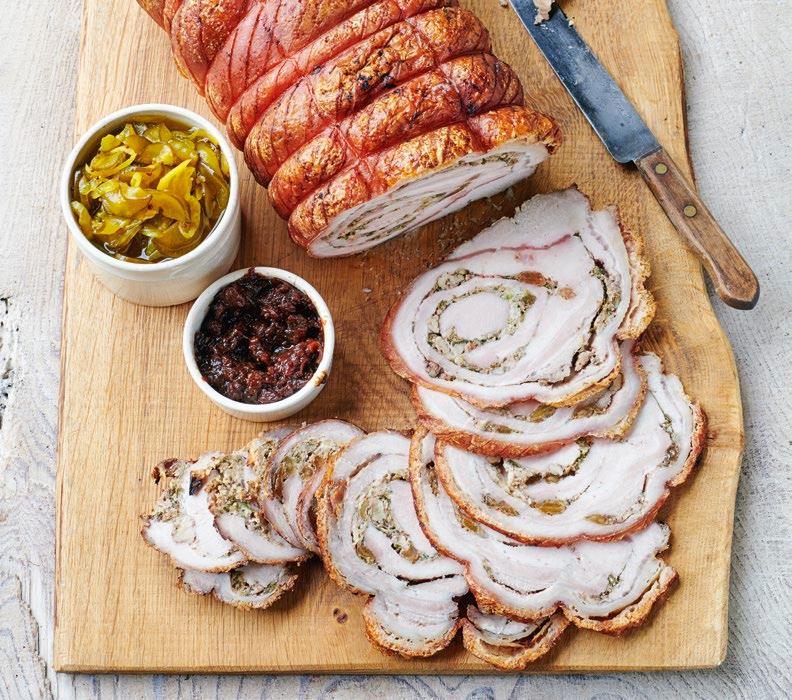
This recipe looks complicated, but it’s actually very simple. It can be eaten hot, but it’s also delicious cold—there’s too much for one meal so it’s great to have cold cuts. The way to get that crackling on the top is to use really good quality
pork. I was brought up on a pig farm so really good quality pork was always at hand, and that’s the key.
Middle White is the best breed to go for with pork. It was particularly popular after the war and has an excellent flavour.


• 3kg boned pork middle loin, skin scored
For the stuffing
• 300g Dorset Blue Vinny cheese, crumbled
• 1 medium onion, grated
• 2 English apples, grated
• 1⁄2tsp ground cinnamon
• 2tbsp fennel seeds
• 100g sultanas
• 100g walnuts
• small bunch of parsley, roughly chopped
• 50g breadcrumbs, chopped
• 2 eggs, beaten
• sea salt and freshly ground black pepper
To serve Chutneys, pickles and/or watercress (optional)
1 Preheat the oven to 240°C/gas mark 9. Put all the ingredients for the stuffing in a large bowl, seasoning well at the end. Mix until all the ingredients are thoroughly combined.
2 Lay the pork on a board and unroll it skin-side down. Using a sharp knife and starting at one end, carefully cut the meat in half horizontally, working almost to the very end so that it’s still attached on one side.
3 Open out the length of the meat so that you have a very long rectangle. Spoon the stuffing over the entire surface of the meat and smooth over so that it sits in an even layer. Starting from the end with no skin attached, roll the meat tightly along its length to enclose the filling.
4 Secure with string: cut a length of string at least five times the length of the joint. Make a noose in the end of the string, loop it around the pork, then pull the string
through the noose and pull it tight. Continue to work down the joint, wrapping the string around the underside of the joint and back around to meet the string at the top, then feeding the string over and under the string at the top, pulling it taught each time. Tie it at the end to secure.
5 Place the pork onto a rack set in a roasting tray and roast for 30 minutes. After this time, turn the oven down to 140°C/gas mark 1 and roast for another 1.5 hours. Remove from the oven and let cool. Transfer to a plate and chill in the fridge overnight.
6 When you’re ready to serve, take the porchetta out of the fridge and leave for 30 minutes to come to room temperature. Cut off the string, slice and serve with chutneys, pickles, and a handful of watercress. n
This recipe features in James Martin’s latest book, Islands to Highlands

In our brand new food series, we travel around the world in search of some of the most interesting and unusual flavours of world cuisine. We kick things off with a hearty, characterful soup from Georgia: kharcho
Fragrant with fenugreek and coriander and thickened with finely ground walnuts, this beef and rice soup is anything but ordinary. Kharcho is a mainstay of Georgian cuisine, including for Georgian Jews. The soup traditionally gets its tangy flavor from the sour plum paste called tkemali, but the more readily available tamarind paste and pomegranate molasses make worthy substitutes.
1 Pulse the walnuts in a food processor, scraping down the sides of the bowl once or twice, until nuts are finely ground with a few slightly larger pieces. Set aside.
2 In a large soup pot, heat the oil over medium-high heat. Working in batches, add the beef and cook, stirring occasionally, until lightly browned, about 5 minutes. Add a drizzle more oil if the pot begins to look dry. Transfer the beef to a plate.
3 Reduce the heat to medium and add the onion, carrots, garlic, and a pinch of salt to the pot. Cook, stirring occasionally, until softened and lightly browned, 8–10 minutes. Add the paprika, fenugreek, coriander, mint, and pepper flakes and cook, stirring, until fragrant, about 1 minute.
4 Stir in the tomatoes, tamarind paste, browned beef, and stock. Increase the heat to medium-high and bring to a boil. Reduce the heat to low, cover, and cook, stirring occasionally, until the beef is very tender, about 1.5 hours.
5 Stir in the ground walnuts, rice, salt, and a generous amount of black pepper. Continue cooking, covered, until the rice is tender, about 20 minutes. Taste and add more salt and pepper, if desired (the amount of salt needed will depend on how salty the beef and stock are.) Serve hot, sprinkled with chopped coriander and dill.

Serves: 6–8
• Preparation time: 20 minutes
• 30g walnut halves
• 3tbsp vegetable oil, plus more as needed
• 910g beef chuck, trimmed of excess fat and cut into 2.5cm cubes
• 2 large onions, finely chopped
• 2 carrots, finely chopped
• 4 garlic cloves, finely chopped
• 1⁄2tsp kosher salt, plus more as needed
• 2tsp sweet paprika
• 1tsp ground fenugreek
• 3⁄4tsp ground coriander
• 1⁄2tsp dried mint

• Cooking time: 2 hours 15 minutes
• 1⁄2tsp crushed pepper flakes
• 240g canned crushed (finely diced) tomatoes
• 2tbsp tamarind paste or pomegranate molasses
• 1.9L beef or vegetable stock
• 50g long-grain white rice, rinsed well and drained
• Freshly ground black pepper
• Roughly chopped fresh coriander and dill, for serving
Add a burst of colour to the corner of your garden by freshening up a shabby outbuilding with a lick of paint
1
As with any painting project, the first step is to carefully prepare the surrounding area before you begin. Lay down tarpaulin sheets or large pieces of cardboard to protect the grass, decking or patio slabs underfoot and don’t forget to tie back or move any plants that are growing nearby. Always check the weather forecast before starting an outdoor painting task; a dry day is needed to avoid water damaging the new paintwork.
2
Use a strong bristle brush to dry clean the wooden panels and remove any dirt or cobwebs that have built up over time. Be thorough with your brushing and be sure to get into all the crevices and joints of the wood. Use masking tape to cover any

Homes and gardens writer and stylist
Cassie Pryce specialises in interior trends and discovering new season shopping
part of the shed you don’t want to be painted, including hinges, locks and window frames. Cover windows with newspaper to avoid paint splattering onto the panes.
3 Once you’ve chosen your paint colour and have done a test patch, you’re ready to begin.
Starting at the top of the shed, use a sturdy roller to apply the paint across the wooden panels (or a spray nozzle if suitable with your chosen paint), ensuring even pressure across the surface. Use a brush to then get into the nooks and crannies and to paint the joints between the panels where the roller can’t reach.
4 Following the instructions on the tin, leave the paint to dry thoroughly before applying a second coat. Some manufacturers will only require one coat, while others will recommend two or three for the best results, particularly for brighter coloured paints. n

Cuprinol Garden Shades in Barleywood, Natural Stone and White Daisy, £20 for 2.5L each, B&Q

We often hear the words “climate change” mentioned on the news, but what are the changes and what can we expect in the future?
Over the past hundred years our world has changed dramatically. Human demand for energy, manufactured goods, transport and animal products have increased carbon emissions from 2 billion tonnes per year in 1900 to a whopping 36 billion tonnes, 115 years later. Namely, as the population and wealth has grown, our planet has suffered the consequences: sea levels rose 15cm over the past century, the Amazon rainforest was cut by 17 per cent in the last 50 years and 60 per cent of all animal species have been wiped out since the 1970s.
Global temperature changes—while now perceived as a negative—are in fact a natural process. Earth’s oceans and land have always warmed, cooled and regulated throughout time of their own accord. However, mankind is now
interrupting the temperature agenda through emissions of greenhouse gases and our atmospheric carbon level has flown over 400 parts per million (PPM) when for millennia carbon had never been above 300PPM. We’ve caused over 1°C of warming since the 19th century and are set to warm by 2-6°C in the next century. For comparison, it took 5,000 years for the Earth to warm up by 4-7 °C after ice ages.
While the small numbers may seem insignificant, this temperature increase has had a huge impact globally; animals and ecosystems can’t keep up with the new rate of change, which forces some species into extinction and a few others into overdrive. In turn, this comes back to haunt humans, who rely on a crucial balance of all ecosystems to sustain our way of life.
Unless we drastically change our habits, our future in a hundred years’ time could be bleak. To tackle climate change, what governments around the world should be focusing on now is: abandoning the use of fossil fuels by replacing them with renewable energy, supporting sustainable farming that diminishes deforestation, creating energy-efficient infrastructure and reducing population growth. Individuals can concentrate on cutting out car and plane travel as much as possible, limiting their intake of animal products, and consuming far less manufactured goods. It will take much more than a village, but it’s possible—and everyone is accountable for what happens next.
How did you become an authority in conservation? I always wanted to be part of a mission to serve the public good, so after more than ten years in the private sector, I brought my corporate experience to the fore as CEO at WWF.
My move was driven by the visible effects of climate change and the growing threat it poses to our planet.
What environmental losses have you seen over your career?
WWF’s 2018 Living Planet Report revealed that global wildlife populations declined by 60 per cent between 1970 and 2014. That’s the equivalent of emptying North and South America, Africa, China, Europe and Oceania of their human populations. That’s a slightly longer period than my career, but it is the merest blink of an eye on an ecological timescale.
What does the government need to do within the next ten years? What we consume in this country has a huge impact elsewhere.
The government should start by legislating to take deforestation out of supply chains, so businesses are required by law to ensure their activities
are not driving the loss of precious forests which store carbon and teem with wildlife. If we lose the Amazon we lose the fight against climate change.
What personal changes can we make to our lifestyles that will have an impact? We can all make a difference: making that journey by rail rather than air, reducing our consumption of meat and dairy, re-using, buying less, and choosing eco-friendly products when we do buy, and switching to green energy.
What hope do we have to hang on to?
We are the first generation who fully understand the damage we are doing to the planet, but the last who have the chance to put things right.
The challenges are huge, but I am filled with hope by the growing numbers of people supporting WWF and similar organisations, making all our work possible. I’m also inspired by the passion of young people who understand that climate change and biodiversity loss pose an existential threat. In demanding action, they are our hope for the future.

Visit WWF.org.uk to try WWF’s environmental footprint calculator
Recently, I read the global pandemic we're living through aptly described as "the great pause". We've been given a glimpse of what our world is like when almost everything comes to a standstill. Fortunately, it's temporary, but if the climate crisis continues, this kind of economic and social disruption could be permanent.

Lisa Lennkh is a banker turned fashion writer, stylist and blogger. Her blog, The Sequinist, focuses on sparkle and statement style for midlife women

From a fashion perspective, I hope that "the great pause" creates a lasting imprint on our decisions around buying clothes. I hope we buy even more carefully, buy only what we need, and only from trusted sources, just as we do with the food we eat. I pray the pause kills the environmental scourge of fast fashion on our planet forever, but I'm not overly optimistic. I've always been an avid supporter of sustainable fashion businesses, but the consideration for my personal responsibility in my own fashion choices has become even sharper due to the pandemic.
Spending all of my time in my home has caused a drastic shift in my wardrobe. My comfortable cotton items are my daily wear instead of just my weekend wardrobe. Comfort,
texture, and, of course, sustainability, guide all of my purchases. I invested in a few key pieces that have suited my working from home needs perfectly, and will also be useful for many years to come as clothes to exercise in.
First up is a luxurious bright turquoise hoodie from Land's End. It's in the spring colour palette, so it looks fresh on the many video calls I do for work. The fabric is so incredibly soft that I'll buy more of these in the future if they make any other colours that suit me. Hoodies have always had a place in my workout and leisure wardrobe. The quality of this one is exceptional, and it is more flattering and cheerful than the faithful soft-grey one I've worn for years.
several pairs and I won't buy any other brand now. Asquith London cotton vests and tees are also a big favourite of mine mostly for the quality of the fabric but also for the beautiful colours. Their fabrics are like wearing a hug. You actually feel the positive commitment to ethical craftsmanship in the clothing.
Another crucial item in my work from home wardrobe is a great pair of slippers. I have a few pairs that I rotate depending on the season and temperature—and washability is key.
I'm a huge fan of leggings; working from home, they are a much more comfortable option than jeans. The best ones I've found are "Flow With It" leggings from sustainable British brand, Asquith London. Every few seasons I check Asquith's new colour range. These particular leggings don't have that awful shiny synthetic look and feel of running tights; they're more for yoga. The fabric is a breathable soft organic cotton and bamboo mix that never pulls or goes sheer after years of washing. I have
I insist on having ones I can wash; I hate the feel of the synthetic fabric and plastic-soled ones that only last for several months and a few washes before falling apart. My recent find are Tom's slippers; they are washable wool and have natural rubber soles. The brand has been committed to corporate responsibility and sustainability since inception, so I like to support them rather than buy the big store £14 throwaway versions.
I hope despite the inconveniences, you find some great things to enjoy during this pause. Fashion is the second most polluting industry on our planet so our choices have a real impact. A slower, more considered way of living and consuming creates a healthier and safer future for all. n
Can crystal facial tools really sculpt your skin to perfection?
Jenessa Williams puts the trend to the test
What are they?
Used for centuries in Chinese holistic wellbeing regimes, crystal facial tools have experienced a new surge in popularity thanks to a push towards more "natural" beauty products that also look great on a bathroom shelf.
Made from semi-precious, coldretaining stones such as obsidian, jade and rose quartz, they are commonly found in two forms—the classic roller, with two different sized balls for face and eyes, and the gua sha, a gently contoured flat stone designed to fit the contours of the face.

Some of the more expensive rollers even have a vibrating function built in to encourage deeper pore penetration—great for those who want to better emphasise their natural bone structure.
Do they actually work?
What are the supposed benefits?
Crystal rollers work by stimulating blood flow in the face to prompt signals to your lymph system—the network of tissues and organs that help remove toxins from the body. This impulse is said to tone the skin and remove the appearance of fine lines or wrinkles by alleviating muscle tension, as well as being a great way to work cleansing products deeper into your skin for more visible results.
In short, yes, but only if used regularly and as part of a wider routine. To get the best out of your roller, store in the fridge and use first thing in the morning or last thing at night, kick-starting the skin into oxygen-absorbing action. There are various sizes and shapes on the market to suit both your whole face and more delicate areas around the lips and eyes—shop around to find the best style for your particular target areas. Apply your favourite serum or moisturiser to your skin as normal, and then roll the stone slowly across your face in upward and outward motions, gently working the product into your pores before rinsing thoroughly. Take your time, and use the moment of calm to shake off the pressures of your day. n


Even a stellar cast that includes Timothée Chalamet, Elle Fanning and Jude Law can’t redeem Woody Allen’s latest calcified romcom
If you look back on Woody Allen’s 1970s heyday with fondness, painfully relating to his protagonists’ awkward romantic travails, excruciating moral struggles and the incidental everyday hilarities of being a full-time neurotic, your heart might skip a beat at the thought of his latest film. After all, the director dips into all his signature pet themes in A Rainy Day in New York, a story about an eager journalism student (Elle Fanning) who gets a chance to interview a famous director in Manhattan, and her nonchalant boyfriend (Timothée Chalamet) who accompanies her on this
trip, counting on a romantic weekend away. There’s witty, frantic dialogue swarming with references, there’s a classic love triangle and, of course, the nonstop fawning over the heady magnetism of New York.
Yet while your serotonin receptors get temporarily flooded with these nostalgic mementos, you soon start to enter strange territory. The film is supposed to be set in modern-day US yet all the references, jokes, and even clothes harken back to the 1950s. Our two leads, supposedly in their early twenties, sport tweed jackets and quote Irving Berlin, which feels like a confusing dream, in which clashing timelines and contexts get jumbled, and the sweet mementos quickly become sad relics, desperately trying to recapture their past magic.


Continuing with the theme of cinematic odes to New York, we revisit the Blake Edwards classic, Breakfast at Tiffany’s. Few things in American cinema are as iconic as Holly Golightly’s little black dress and oversized cigarette holder, as the socialite gallivants around Manhattan’s trendy East Side, flirting with unassuming rich men and drinking champagne.
It’s surreal to imagine anyone but Audrey Hepburn in that role, making it hard to believe that Truman Capote, the author of the novella that inspired the film, was outraged when Hepburn was cast. The author’s heart was set
on Marilyn Monroe and he accused Paramount of “double-crossing him in every way” by choosing Hepburn. But we’re so glad they did: it’s unimaginable to think of Holly Golightly without those dainty elfin features and mischievous spark in her eyes. The supporting cast is equally memorable and flamboyant, including George Peppard as Holly’s stoic love interest: a struggling writer and a kept man of a rich matriarch played by Patricia Neal: a domineering, whipsmart woman who knows what she wants. Everyone here is dressed to the nines, always has a witty quip up their sleeve (“Promise me one thing: don’t take me home until I’m drunk”), and an important role to play in the never-ending party that is life in New York. Yet the Big Apple is arguably the most important player here, with its brownstone apartment blocks, yellow cabs and glistening luxury department stores, all captured through vibrant, sunshine-soaked Technicolor.
It’s one of those movies that offers entertainment in its purest form—up there with the likes of Singing in the Rain and Some Like It Hot—that feels like (a very elegant) comfort blanket every time you return to it.
by Eva MackevicStrange days for humankind, but a boom time for television. The clocks had barely sprung forward when our broadcasters started pushing their drama heavyweights, confident that lockdown made us an unusually captive audience. The BBC has set understandable stall in the third and final series of Killing Eve (BBC1; iPlayer), which continues to deliver leftfield twists and costume changes while avoiding paying out on its titular promise. We’re left watching two excellent performers engaged in an eternal game of cat-and-mouse: fine, but all rather more formulaic than this show once appeared.
Altogether fresher is Run (Sky Comedy; NOW TV), penned by Phoebe Waller-Bridge’s sometime writing partner Vicky Jones. It has a familiarsounding romcom premise—two college sweethearts, now in their thirties, go on the lam together after jilting
their current partners— but casts Merritt Wever and Domhnall Gleeson who lend it idiosyncratic rhythms and stresses. What if the one who got away only got you into further trouble still? Wherever we’re headed, the leads make for lively travelling companions.
The season’s big disappointment is TheEddy(Netflix), in which La La Land director Damien Chazelle strands charismatic actors in an unrewarding slog around the Parisian jazz scene. For name filmmakers making superior TV, look instead to the BBC’s exceptional adaptation of Sally Rooney’s bestseller
NormalPeople(BBC1; iPlayer), overseen with notable (and not untypical) sensitivity and precision by Room’s Lenny Abrahamson. Lonely hearts connecting: we’ll always have a hankering for that, but surely never more so than after weeks of enforced isolation.
 by Mike McCahill
by Mike McCahill
TheGoldenGirls (Channel 5; My5) are pepping up their lunchtime schedules with this spritely sitcom perennial, centring on four grey-haired BFFs embracing the possibilities of later life. Timely comfort viewing: a Werther’s Original for the soul.

CONCERTOby GABRIEL PROKOFIEV
Composer Gabriel Prokofiev has never been one for convention and, judging by the sound of his new album, he’s not planning on giving up that reputation anytime soon. A follow up to his recent concertos for the saxophone and bass drum, this time he explores the musical capabilities of the turntable (yes, you read that correctly) and cello. It’s a surreal, cinematic affair that’ll bust any preconceptions you may have about “serious” music. An impish bastard child of classical and industrial genres, it relishes teasing you with fake “glitches” in the audio before coquettishly returning to its normal course. And, well… we’ll bite. Every track is fiercely individual, employing a different “scratch” technique and inhabiting a totally different mental space; some sound like a slasher film soundtrack as rendered by Salt-NPepa; others are harbingers of death of Wagnerian proportions—ones you can dance to, oddly enough. It’s an original, livingbreathing thing that’ll push your buttons and slip from your grasp anytime you try to file it under some category.
by Eva MackevicWhile you may mostly associate turntables with the rise of hip-hop in the 1970s, experimenting with them in music actually started as early as the 1930s. Classical music’s rebel, John Cage (of 4’33 fame), made the first composition with turntables entitled ImaginaryLandscapeNo.1in 1939, which is often credited as the first electroacoustic music ever composed.
“Scratching” (the sound made when the record is moved back and forth) itself, you’ll be amused to find out, was invented by accident by rapper Grandmaster Flash when he once stopped the record with his hand to hear what his mother was shouting out to him. Since then, the technique has been used to produce percussive sounds within many different genres, and numerous scratch techniques, such as “the baby”, “the crab” or “the transformer” have been developed.
Two page-turning, unputdownable novels take centre stage in our June reading picks
All Fall Down
by M J Arlidge (Orion, £12.99)Readers of M J Arlidge’s previous books won’t be surprised to hear that there’s another serial killer on the loose in Southampton. Or that DI Helen Grace must crack the case while also juggling her complicated love life and driving very fast on her Kawasaki motorbike. Or that the action moves almost as quickly as the Kawasaki itself, with anybody planning to read “just one more chapter” likely to be foiled by the fact that most of the chapters are short and end on a crunching single-sentence cliffhanger.

being both formulaic and fresh at the same time: we know what to expect, but we didn’t expect it quite like that. Certainly, it’s hard to imagine even the most grizzled Arlidge veteran working out what’s going on in All Fall Down—a book once again filled to the brim with great twisty plotting, before reaching a climax in which Grace and the killer meet oneon-one…
The Sight of You by Holly Miller (Hodder & Stoughton, £12.99)
But, of course, this is precisely Arlidge’s appeal—and the reason why the Helen Grace novels sell in such large numbers. Like many a fine thriller writer, he’s perfected the neat trick of

James Walton is a book reviewer and broadcaster, and has written and presented 17 series of the BBC Radio 4 literary quiz
The Write Stuff
Callie is 34, working in a café and a bit lonely when she meets Joel, who seems pretty much a dream man. Not only is he funny, kind and handsome, but he’s clearly smitten with her too. So what could possibly go wrong? The answer, rather unexpectedly, is that Joel has dreams which accurately predict the future—and the one about Callie is an out-and-out nightmare.
In theory, this premise should be distractingly hard to swallow. Yet by presenting it so matter-of-factly, and thinking through its implications so

poignantly, Holly Miller creates a proper romantic novel (complete with two central characters you can’t stop rooting for) that also raises some big questions about mortality. If you could, would you like to know the date of your death or that of those close to you? And if you did, would that change the way you live?
With endorsements from the likes of Jodi Picoult, publication across the world, and a Hollywood deal already in the bag, Miller’s debut looks primed to be a big summer hit. If you read it, my guess is that it won’t take you long to see why.
Can you guess the writer from these clues (the fewer you need the better)?
1. As a government spy, he helped to bring about the 1707 union of England and Scotland.
2. For obvious reasons, there’s been a recent revival of interest in his 1722 book AJournalofthePlagueYear.
3. His most famous novel is about a man on a desert island.
Answer on p126
LadyinWaitingby Anne Glenconner (Hodder, £8.99).
A former lady-in-waiting to Princess Margaret and maid of honour at the Queen’s coronation, Glenconner takes us behind the royal scenes in this irresistible, sometimes jawdropping memoir.
TheSecond-WorstRestaurant inFranceby Alexander McCall Smith (Polygon, £8.99). In his second novel featuring the Scottish cookery writer Paul Stewart, McCall Smith is as witty and shrewd as ever.
BrothersinArmsby Geraint Jones (Pan, £8.99). Vivid and candid stories of the war in Afghanistan from a British ex-soldier.
AForget-Me-NotSummerby Sophie Clare (Hodder, £8.99). Charming slice of escapist romance, set in Provence—although this year the book may be more of a substitute for a summer holiday than an accompaniment to one.
TheGoldenFleeceby Esther Rutter (Granta, £9.99). Thoroughly well-informed—to the point of slightly obsessive—account of the history and present state of knitting in Britain.

The trials and triumphs of isolated living are laid bare in this often shatteringly honest read
In 2004, Tamsin Calidas and husband Rab left London to live more simply on a croft in the Hebrides. Or at least that was the plan. In fact, living more simply turned out to be very difficult— which is why I Am an Island is by no means the usual self-deprecating, comic tale of townies roughing it among loveably eccentric locals
before triumphing over the odds. Instead, it’s a lot wilder, stranger and more interesting than that.
Calidas writes beautifully about the weather and landscape of the unnamed island (population: 140). Yet, this only emphasises how bleak they both can be.
Nor does she sugar over the hostility of many islanders to their two English invaders. And that’s before things really start to go wrong. Having hoped to raise a family on the croft, she discovers she can’t conceive (even by the standards of this often painfully honest book, she’s utterly unsparing about how shattering that is). She and Rab then split up, and he goes back to London, leaving Calidas to fend for herself— and the sheep—alone.
For a lesser woman, that might well have been that. Rather to her surprise, though, Calidas realises she’s in it for the long haul, learning not merely to put up with loneliness and hardship but to embrace them. Now, 15 years after arriving, she’s in no doubt that the island is her true home and the natural world her teacher and friend. Honest to the end, she doesn’t pretend she’s happy exactly. But she does have a powerful, even mystical sense of being where she belongs.
We join her here when Rob has recently left and, just to add to her problems, she’s running out of money and food…
In the end it is simple. Everyone needs to eat. I am hungry and I do not have enough food. When there is nothing indoors but stone walls and floors, the only place to go is outside. One day, in the garden, I hear my stomach churning with hunger. I reach out and snap off a handful of greenery. I examine it, and then peer closer. I find myself wondering how it would taste. I am shy of eating leaves at first. It feels too feral, desperate. But the advantage is that there are plenty of them. It is a reassurance to know that as long as the sun keeps shining and the rain keeps falling, this is one source of food that will not run out.
I turn the leaves over, holding them up to my nose. I strive for words that will help me identify the plant. Fresh, green, herbaceous, a hint of citrus, I think as I rub a leaflet between my fingers. But these descriptions are too general. They could be applied to most plants. This makes me cautious. The leaf leaves a green stain on my fingertips, which I hesitantly lick. I want to be sure it is not poisonous. Plant identification is critical. Many years before, I studied herbal medicine in London. I kept my notes and over the last months have made my own checklist. I can tell this plant is rowan. The leaves are long and oval, with a tooth-like rasped edge. I know it is safe. So I take a tentative bite, gnawing at its edges, and then folding it over and
IT TAKES A SURPRISINGLY LONG TIME TO EAT A LEAF FRESH OFF THE TREE
crushing it in my mouth. It feels abrasive, like biting into rough paper, but I persevere. After a minute of running it over my tongue, I chew slowly so that its flavour comes through. It tastes bitter, acrid, sour in that first rush of sensation.
‘Here,’ I offer one to my dog, who is watching me closely. She sniffs it, licks it inquisitively and turns away as if affronted, the look in her eye one of disgust.
‘Oh, come on,’ I tell her, ‘it’s not that bad.’ And then I look over my shoulder, quickly. Because it feels
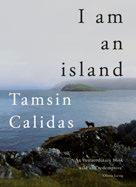
I Am an Island (Doubleday) is available for Kindle and as an audiobook, and available to pre-order in hardback
somehow savage, standing in my garden, cramming raw leaves into my mouth.
It takes a surprisingly long time to eat a leaf fresh off a tree. The thick sycamore leaf is the toughest. The beech is soft, ruckled, with tiny hairs like a downy skin. Blackthorn pricks your fingers if you are not careful, whilst the hawthorn is as coarsetextured and dense as the silver birch is thin and slippery-cool. Tasting those first few mouthfuls feels strange, like an illicit secret in my mouth. But it is more than that. It is a relief. I am ravenous, desperate for food. So the next morning, I get up early and go out furtively, this time with a deep basket. I make a promise to take only what I need.

Tamsin Calidas’s favourite books of the Scottish Highlands and islands
TheOutrunby Amy Liptrot. A brave, searing memoir of addiction, and being washed up home to Orkney, aged 30, to start afresh.
SpadeAmongtheRushesby Margaret Leigh. I read this book— about life on a remote Highland croft in the Second World War—when I first stumbled on my own croft, and I still love reading of Leigh’s struggles and love of the wilderness.
IslandYears,IslandFarmby Frank Fraser Darling. This often travels with me. I love his detailed observations of bird life, wry humour and gentle pace.
TheSeaRoomby Adam Nicolson. Truly, one of the most beautifully written books I have ever read. Memoir, nature writing, history and adventure—totally stunning.
And the name of the author is… Daniel Defoe, author of Robinson Crusoe.AJournalofthePlagueYear mentions—among other things—the forced closure of taverns, the empty London streets and the courage of public officials.
TheManWhoGaveAwayHis Islandby Ray Perman. Perman explores the sustainability of island ownership. His book also gave me a wonderful introduction to his wife, Margaret Fay Shaw, and their preservation of Gaelic song, culture and folklore.
Diana Evans is a British novelist. Her new novel, Ordinary People, is out now, published by Chatto & Windus

Jean Rhys’s acerbic chartings of the dark days and various humiliations of the lone and penniless woman of a certain age are brief yet unforgettable. Although her geographical settings often feel placeless—existing in a kind of mist—this novel evokes the oppressiveness of London and the comparative looseness of Paris, each place unable to offer Julie, the central character, an escape from herself. Rhys’ protagonists always display an inner triumph, their failures a success against the cruel systems of exploitation and capitalism, even if only in naming them, in pointing them out. This novel also conveys alienation within families with depth and psychological exactitude.

This was the first book I read by Alice Walker and she has been one of my favourite authors ever since. There is a quiet grace alongside a formidable, uncompromising power in her writing, a refusal to express anything but the truth. This is a many-layered, many-voiced, disjointed and esoteric kind of novel, ambitious in its scope and ethereal in atmosphere, abounding with myths and shedding light on black and marginalised lives in America. It made me see, even before I discovered that I was a writer, that there is adventure, freedom, and spiritual and mental healing in the serious arrangement of words.

I have some problems with John Updike and his portrayals of women and his general blinkeredness, but he is nevertheless important to me in terms of his writing style and his approach to the act of writing, similar to that of a visual artist. He draws and paints life beautifully, observing the world, fully conjuring it on the page. This novel follows the interconnected lives of suburban couples and was an initial inspiration for my novel, Ordinary People, in its close attention to the details of their everyday realities and interactions. It highlighted to me the stark lack of such writing about less visible characters, and the need to correct that.

James O'Malley on how artificial intelligence can empower your everyday life
Today is often described as the "era of the smartphone". But a change that is equally—if not more— important than having the internet in the palm of our hands is also taking place. It isn’t simply that computers now work faster, but they have also been "thinking" differently. And this new way of thinking, which has been dubbed “artificial intelligence” (AI) is changing our world. AI is about spotting patterns. Traditionally, computers have solved problems by following instructions that have been written by a human. But some problems are just too complicated for a human to describe.
For example, say you wanted a computer to determine whether any given picture includes a tree, then one way of approaching the problem could be to write some code telling the computer what to look for: branches,
leaves, roots and so on. But this is imprecise—it might miss some trees, or even miscategorise any shrubs or plants that appear to fit the bill.
So instead, we turn to AI. If we feed the computer, say, 10,000 pictures that we know contain trees, and 10,000 without, and tell it that the first set contains trees, and the second set doesn’t, the computer can then analyse the images and figure out what are the qualities that truly describe what a tree is. It will analyse the images to notice differences and patterns that we humans are unable to spot. After, if you were to show it one more picture, it would be able to make a good guess as to whether a tree is present or not. And the more images you “train” an AI with, the better it gets at guessing. What makes it truly revolutionary is that this technique
can be applied to almost countless tasks. The computer isn’t really looking for trees like humans are, it's looking at sequences of ones and zeroes. So you can use the same technique to look for patterns in
anything—photos, audio or text.
Voice assistants such as Siri and Amazon Alexa are only possible because of AI: when we speak to them, they are doing the same sort of pattern spotting. When we ask, “Is it going to rain tomorrow?”, the systems are able to compare our voices to thousands of previous examples of people asking the same question or using the same words.
Music apps such as Spotify use AI too, to generate playlists and recommendations. By looking for patterns in what we listen to, it can compare our listening to that of other users, and then add tracks the other users like to our recommendations, all on an individualised basis.
Google too makes extensive use of AI, with it now a core component of most of Google’s tools—including
search. Google Maps is another example. An AI has been trained to spot patterns in how traffic behaves, so that when you ask it to plot you a route, it will be better at predicting which roads will be busy and which ones will not.
Crucially though, AI is not just for Big Tech. It’s now routinely being used by, well, everyone.
For example, banks are now using AI to spot fraudulent activity. By looking at the transactions taking place, AI is capable of spotting unusual spending patterns, that humans simply looking at a list may be unable to spot—meaning that fraud is spotted more quickly.
Similarly, grocery retailer Ocado is using AI in different applications all over its warehouses, from using “computer vision” cameras to check that bags are open and ready to receive goods, to deciding the order in which stock is stored on shelves. This means that the company can improve the efficiency of its warehouses.
And in the future, when driverless cars finally arrive, that will all be thanks to AI too, as the camera and LIDAR sensors that autonomous vehicles use to navigate will feed what they see to a computer trained using AI, in order to identify objects and hazards on the road.
So maybe this isn’t really the era of the smartphone. Perhaps the history books will look back and remember something different: the birth of AI. n
Win £30 for your true, funny stories!
Go to readersdigest.co.uk/contact-us or facebook.com/readersdigestuk
My husband is a junior sports coach and during a recent training session he was trying to teach the children that when attempting to score a goal, they should kick the ball with the laces of their boots. One young boy stuck his hand up and commented, “I'm going to have a problem. I only have velcro on mine.”
DEENA COULSON, CambridgeshireI don't think my nephew quite got the concept of becoming an older brother. When his mum got home from the hospital with her new baby son he seemed quiet for a couple of hours. Then he tugged his dad's sleeve and asked, “When are his mummy and daddy coming to pick him up?”
LEONA HECKMAN, Denbighshire
I took my young daughter on a bus ride to town. Sitting in front of us were two ladies having an animated conversation. My young daughter, who had been unusually quiet for much of the journey, suddenly
reached over, tapped one of the ladies on the shoulder and said, “Could you repeat that again? I couldn't hear you properly.”
Unbeknown to me, she had been eavesdropping the whole time!
SUSANNA LEWIS, Yorkshire
In a geography lesson, I asked my class if anyone could find South America on the map. A boy named Kyle pointed to it. After, I picked another sleepy looking pupil and asked him who discovered America.
He awoke with a start and retorted with, “Kyle, Miss.”
KAITLYN AITKINS, Merseyside
My sister and I look very alike and are often mistaken for each other. While on holiday, my sister and her husband stopped at a street stall to buy fresh coconut water. Two days later my husband and I stopped at the same place and one of the lads ran up to the car smiling, carrying a bottle of coconut water. As he got to the window, he hesitated, looked at

us and shouted to his colleague, “She came back with another man today."
MARGARET ANNE ROBERTSON, Kent
My daughter was watching Alice In Wonderland on telly when she must have overheard her dad and I have a slight disagreement. She always sticks up for me, so she decided to tell him loudly, “Off with your head!”
CORRINA WILLIAMS, Denbighshire
My mum was making beef stew and asked me to taste it to see if it needed any more salt. I said no and pointed out I'd been a vegetarian for over 30 years to which she replied, “I didn't put any meat on the spoon.” Next she'll be offering me a slice of wafer thin ham!
ANN JOHNSON, Cheshire
When I was 13 I was top of my class in French, so when a young boy from Angoulême stayed with me on an exchange programme I relished the chance to show off my language skills. One morning I asked him (in
French) if he needed a clean towel, but it was only later that I realised I'd actually asked him if he wanted a sanitary towel—no wonder he'd looked so bemused!
RACHEL HOWLETT, Bedfordshire
My seven-year-old nephew asked me where babies came from.
My sister, thinking on her feet, replied, “Remember when we made a cake? We mixed eggs, sugar, butter and flour. It’s like that. The egg from the mummy is mixed with the sperm from the daddy and it makes a baby.”
My nephew thought for a bit and then asked, “Do you use a fork or a whisk?”
SUE BUCKINGHAM, Monmouthshire
I got a text from my dad while he was holiday in South Africa which said, “It's hot here. And I got rabies.”
I was rather alarmed but thankfully he quickly texted back, “Whoops, predictive text, I meant I got Ray-Bans!”
DEENA COULSON,
Cambridgeshire
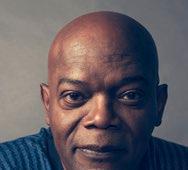








YES I want to subscribe to Reader’s Digest Magazine for just £3 for 3 issues (a saving of £8.37 on the shop price of £11.37 based on the cover price of £3.79 per issue). I understand that if I do not wish to continue receiving Reader’s Digest after my first 3 issues I can simply cancel my subscription by contacting customer services. If I do want to continue to subscribe after my first 3 issues I need do nothing and my subscription will automatically be renewed at the low rate of £7.50 for every 3 issues until I decide otherwise.

IT PAYS TO INCREASE YOUR
This month we look at how language can help us be sneaky. Whether you’re playing a game, turning life into a game or trying to game the system, here are some words to keep up your sleeve
BY JOAN PAGE MCKENNA1. palindrome—A: word or sentence that reads the same backwards and forwards. B: long-term strategy. C: surprise manoeuvre.
2. alibi—A: Ironman triathlon ability. B: equally adept on land and in water. C: an excuse.
3. gambit—A: ploy. B: winning point scored just as time runs out. C: repetitive chant at sporting event.
4. spooring—A: reading inappropriate meanings. B: teaming up with unlikely allies. C: tracking by following a trail.
5. jobbery—A: well-executed sleight of hand. B: corruption in public office. C: fast-moving con.
6. subterfuge—A: online troll. B: deception. C: noble adversary.
7. pawky—A: sly sense of humour. B: given to practical jokes. C: offcolour joking.
8. roister—A: back opponent into a corner during a boxing match.
B: shake down for money. C: engage in noisy revelry.
9. red herring—A: puzzle. B: decoy. C: difficult problem.
10. conundrum—A: symbol for infinity. B: puzzle that uses pictures to represent words. C: problem.
11. kangaroo word—word that A: has paired vowels. B: contains another word that is its synonym. C: only appears as a plural.
12. eccedentesiast—A: one who fakes a smile. B: cheats at everything. C: knows how to beat a lie detector test.
13. cipher—A: witty retort, thought of too late. B: nonentity. C: gypsy mind reader.
14. aleatory—A: dependent on chance. B: hypercompetitive. C: imaginative.
15. phantasmagoria—A: menacing sounds. B: famous Disney movie. C: series of bizarre images.
1. palindrome—[A] word or sentence that reads the same backwards and forwards. Bad at small talk, Vida yelled “Palindrome!” when the client said, “Stats.”
2. alibi—[C] excuse. After working late to set up his brother’s surprise party, Chan needed an alibi.
3. gambit—[A] ploy. Releasing the virus was the only gambit that had a hope of breaching the fire wall.
4. spooring—[C] tracking by following a trail. The park warden taught the kids spooring by helping them spot a bent-down blade of grass.
5. jobbery—[B] corruption in public office. Accused of jobbery, the once-popular mayor saw his approval ratings plummet.
6. subterfuge—[B] deception. To trick kids into eating broccoli, learn the art of subterfuge—smother the vegetable in grated cheese.
7. pawky—[A] sly sense of humour. Liam’s pawky wit made him a favourite at dinner parties.
8. roister—[C] engage in noisy revelry. If we win the big game, forget sleep: fans will want to roister.
9. red herring [B] decoy.
Agatha Christie had a gift for creating red herrings—characters that diverted attention from the true killer.
10. conundrum—[C] problem. My sister and her boyfriend are vegans, so making meals everyone can eat is a real conundrum.
11. kangaroo word—[B] word that contains another word that is its synonym. “Splotch” is a kangaroo word containing “spot.”
12. eccedentesiast—[A] one who fakes a smile. Come to my family’s Christmas dinner, and you’ll see a room filled with eccedentesiasts.
13. cipher—[B] nonentity. Supporters were worried. For all his charisma, their candidate was still a cipher.
14. aleatory—[A] dependent on chance. My sensible father never joined us at Texas Hold’em. The aleatory nature of the game put him off.
A casually employed dock worker
Alternative suggestions: "Hen and Go: Shampoo for chickens"
"Somebody who is known for their shenanigans"
15. phantasmagoria —[C] series of bizarre images. Last night, my dreams consisted of a phantasmagoria of human-like animal faces.
VOCABULARY RATINGS
7–10: Fair
11–12: Good
13–14: Excellent

After spending far too much time on apps and social media over the last few years, Gemma decided it was time for a change.
“I’d started to get really frustrated with how I was spending my spare time”, said Gemma, 54 from London. “One day, I realised I’d checked my phone over 100 times. Something had to give.”
“So, I deleted my social media apps from my phone and made a promise to myself to do something more positive with my time.”
At first, it wasn’t easy for Gemma to find things to do.
“I’m embarrassed to admit that I’d stopped reading as much over the last couple of years. But, then a friend recommended Readly to me. I’d always loved reading magazines and thought it was time to give them a go again.
The selection is amazing: food, fitness, lifestyle, culture, crafts and

hobbies are all covered. I’ve been using Readly in the evenings to relax instead of watching TV. I’ve also found it great for inspiration and ideas for new recipes. We’ve been doing some re-decorating, so the interior design section has been really helpful. Having so many past issues to browse through is just fantastic. I can’t think how much I would’ve had to spend to get all that content. If you read more than a couple of magazines, you’ll be saving money each month.
My husband loves the car, sport and business magazines. And we cuddle up and do the puzzles and crosswords together now as well!
As it’s a family membership, I’ve shared my subscription with my daughter who has started using it. She’s a teacher and loves getting inspiration from the kids news, science and history magazines.”
To find out more about Readly, and to try 1 month for free, please go to www.readly.com/digest
Challenge yourself by solving these puzzles, then check your answers on p139
The nine pictures go into the grid in such a way that the descriptions on the edges are true for the first picture in the corresponding row or column in the direction of the arrow. There can’t be more than one picture per cell. Where does each one go?
plant life
can have people inside has windows is alive
found in nature found on land
stays in one place goes underwater is manmade is attached by a stem has wheels in animal kingdom
made of metal often sits on water flies has wings
The lock on a safe has a six-digit code. The second digit is two more than the fifth digit. The third digit is double the first digit. The fourth and fifth digits add up to the sixth digit. The fourth digit is two less than the fifth digit. If all of the digits add up to 29, can you figure out the code of the safe?
birchbark canoe
aeroplane tree submarine
leaf house fish duck bird
Your name is Jerry Mander, and you have a history of rigging local electoral maps. Before retiring to enjoy your ill-gotten gains, you’ve decided to collect one last bribe from mayor George Cherry. Draw voting districts so that Cherry remains mayor instead of getting defeated by his more popular rival, Les Indigo. This map shows which household supports which candidate. Divide it into five districts of five contiguous households so that Cherry will get the majority of the votes (at least three households) in the majority of the districts (at least three districts). For a district to be contiguous, each household must share a border with at least one other, and shared corners don’t count. (Jerry m an D er’s Last Hurra
You and a group of friends are about to be seated in random order around a circular table, with no extra chairs. The probability that your one best friend will be sitting next to you is equal to the probability that she will not. How many people are in your group?
In each outlined region, put a whole number into all of the cells, counting up from 1, moving in numerical order from square to square. The count can move only horizontally or vertically within the region, not diagonally. No number may touch a copy of itself horizontally or vertically between regions. One number has been given.




WIN £30 for every reader’s joke we publish!
Go to readersdigest.co.uk/contact-us or facebook.com/readersdigestuk
My brother just admitted to me that he broke my favourite lamp.
I’m not sure if I’ll be able to look at him in the same light ever again.
Comedian GARY DELANEY
The very existence of flame-throwers proves that sometime, somewhere, someone said to themselves, “You know, I want to set those people over there on fire, but I’m just not close enough to get the job done.”
Comedian GEORGE CARLIN
I like to play chess with old men in the park. Though it’s proving hard to find 32 of them…
Comedian EMO PHILIPS
Warning: To the person who stole my spectacles. I will find you. I have contacts.
RYAN AITCHISON, Wirral
I’ve got a belt on, which is holding up my trousers, and my trousers have got belt loops that hold up my belt. I don’t really know what’s actually happening down there. Who’s the real hero? Seen on Reddit
I hate dreaming, because when you want to sleep, you want to sleep, you know? There I am, laying in my comfortable bed in my hotel room. Next think you know I have to build a go-kart with my former landlord.
Comedian MITCH HEDBERG
What did the Buddhist ask the hot dog vendor? Make me one WITH EVERYTHING!
Seen online
I went to my doctor and asked for something for persistent wind. He gave me a kite.
Comedian LES DAWSON
My husband can do the work of two men. Unfortunately those men are Laurel and Hardy.
Comedian JO BRAND
About a month before he died, my grandfather decided to cover his entire back with lard. After that he went downhill very quickly.
Comedian MILTON JONES
My mum is so pessimistic, that if there was an Olympics for pessimism, she wouldn’t fancy her chances.
Comedian NISH KUMAR
I was at a casino, standing by the door, when a security guard came over and said, “You’re going to have to move, you’re blocking the fire exit,” as though, if there was a fire,

TWITTER USERS HAD A FIELD DAY AFTER THE QUEEN GAVE HER LOCKDOWN SPEECH DRESSED IN GREEN… via boredpanda.com


I wasn’t going to run! If you are flammable, and have legs, you are never blocking a fire exit.
Comedian MITCH HEDBERG
Mine was a tough school. The teacher said to the class, “What comes after a sentence?”
A kid replied, “You make an appeal.”
Comedian STAN BOARDMAN
Daddy long legs are really creepy. But not as creepy as whoever decided to name them daddy long legs.
Submitted via email
Word on the street… is graffiti. Seen on Reddit
It’s really hard to explain “virtue signalling”, as I was saying the other day to some of my Muslim friends, over a fair-trade coffee in our local feminist book shop.
Comedian LUCY PORTERI entered a competition last week and I won a year’s supply of Marmite! One jar. Seen online
It’s really hard to still enjoy milk when you really think about where it comes from.
For example, I steal all mine from this after school youth programme. Seen on Reddit
I just read the Ten Commandments for the first time. Must suck to be that “Thou” guy.
Submitted via email
Twitter users share some hilarious tweets about the children in their lives.
@VacayWithBrooke: My fouryear-old said, “Daddy doesn’t have to wear a seat belt. His belly will protect him.”
@KeithBristol: My wife and I recently asked our daughter what she learned in health class. She said, “I learned that boys have tentacles.”
@CDNels: My daughter was given a KitKat as a treat. A short while later she handed us the crispy insides with all the chocolate bitten off and said, “Here’s the bones.”
@LlamaSugar: My son told his sister that dinosaurs were around a long time ago. “The 1970s, I think.”
CROSSWORD ANSWERS
Across: 9 Earthworm, 10 Octet, 11 Encores, 12 Ensnare, 13 Problematical, 20 Hi-fi, 21 Allot, 22 Mayo, 23 Temperamental, 32 Stomach, 33 Support, 34 Rouse, 35 Surveying
Down: 1 Jewel, 2 Grocer, 3 Cherub, 4 Mousse, 5 Amoeba, 6 Bonsai, 7 Ottawa, 8 Utter, 13 Print, 14 Odium, 15 Lease, 16 Malta, 17 Tithe, 18 Comet, 19 Loyal, 24 Exodus, 25 Peaked, 26 Rehash, 27 Misery, 28 Nephew, 29 Adonis, 30 Tsars, 31 Stags
We chat to everyone’s favourite fox, Basil Brush
WHAT’S THE BEST PART OF YOUR CURRENT SHOW?
I’ve got two shows, I’m rather a greedy fox. I’ve got a family fun show and there’s also Basil Brush: Unleashed which is a wonderful, slightly more grown-up show. Getting the grown-ups on the stage to have a conversation is great! They can’t believe they’re chatting to a real-life talking fox.
WHO INSPIRES YOUR COMEDY?
Originally I was inspired by Terry Thomas, a suave, dapper gent of the 1970s. Now I want people to smile and put their troubles away. I recycle some terrible old jokes too: I went into the park the other day and the police arrested a man for impersonating a helium balloon, they held onto him for a while and then they let him go. Boom boom!
DO YOU FIND ANY PARTS OF THE COUNTRY FUNNIER THAN OTHERS?
The further north one goes, the more raucous the audience are. Especially in the family fun shows, the kids tend
to be terribly well behaved down south while the folks up north let themselves go a bit more.
IF YOU WERE A FLY ON THE WALL, WHOSE WALL WOULD IT BE ON?
Ed Sheeran, I want to know whether he really writes his songs or has secret writers because they’re always so good! Is he really that talented? He probably is to be honest.
WHAT’S YOUR FAVOURITE ONE LINER? I love YouTube, memes and TikTok, and recently saw a man say, “Do you know the difference between Dubai and Abu Dhabi? The people in Dubai don’t like The Flintstones. But the people in Abu Dhabi do.” Boom boom!

WHAT’S YOUR BIGGEST PET PEEVE?
I hate when people are eating and scrape their cutlery on the bowl. It’s worse than dragging your fingers across a blackboard. Pick it up and lick it I say! n
Basil Brush is touring with the Wychwood Festival in 2021. Visit wychwoodfestival.com

Think of a witty caption for this cartoon—the three best suggestions, along with the cartoonist’s original, will be posted on our website in mid-June. If your entry gets the most votes, you’ll win £50.
Submit to captions@readersdigest.co.uk or online at readersdigest.co.uk/fun-games by May 7. We’ll announce the winner in our July issue.

Our cartoonist has been left without his crown once more, as his caption, “There’s someone who’s important to you… his name starts with an S… no R!” couldn’t compete with our reader, Linda Dalton, who won voters over with her funny suggestion, “I see many months of lockdown in a cave.”
Jo Caird explores the formative role that doll houses play in many of our lives
He’s famous for his biting tongue and sharp wit when it comes to reviewing restaurants. Now, Jay Rayner talks us through the hilarious laws he’d implement if he was left in charge
Stories of the South London district from those who call it home +
LAUGHIn this advert each word represents one mil e dri ven in an electric car. So far you’ve driven eighteen miles and all’s well. You’re on full charge, the kids are dropped o ff and you’re heading out for the day. T h e driving’s smooth, quiet and you’re clocking up brownie points for being emission free . But which car are you drivin g ? Well, by the end of this wor d, you’ve reached sixty five miles and the battery still looks very healthy. You’re on your way to pick something up from your sister’s before the trip this weekend and you know t he traffi c o n the B roads is going to be a nightmare. But off you go regardless. After an hou r, you turn onto her road just before this comma, or one hundred and twenty five miles, confident you won’t need to plug in for a while yet. Job done you hit the road again, you’ve still got further to go. Back at the school gates, you bundle the kids into the car and you’re ready to go, heading up the motorway for a weekend away and a chance to flee the urban jungle. Finally, you pull up at the hotel and plug the car in, amazed you’ve driven two hundred and f i ve mile s on a single charge, not far off your car’s whopping two hundred and forty five mile r ange. Which means
t h ere’s just fourteen
w ords left to reveal
w hich electric car
y ou’ve been
t
R

Zero tailpipe emissions. CO 2 while driving: 0 g/km, MPG: n/a according to WLTP homologation tests. Model shown GT Line R135 238 miles. Play R110 up to 245 miles. WLTP figures for comparability purposes. Figures obtained after the battery was fully charged. Actual real-world driving results may vary depending on factors such as accessories fitted after registration. For details visit renault.co.uk/zoe. 5 year warranty on cars ordered from 18 December 2019 – 5 years or 100,000 miles (whichever comes first). Exclusions apply visit renault.co.uk/warranty.











